Asustor Flashstor 12 Pro FS6712X NAS Hardware Review
The sheer range of solutions available to home and prosumers who want to store their data in their own personal NAS server is genuinely staggering! It’s easy to forget that it wasn’t that long ago that most home users really only had about 3-4 different profiles of desktop devices to opt for – with everything else being designed for business and enterprise users. However, in the last few years, we have seen rackmount turnkey solutions that are genuinely home-user accessible, powerful hardware arrive in more compact servers that better suit home/prosumer enthusiast deployment… and then you have the Flashstor! The Asustor Flashstor is the first genuinely home user-accessible M.2 NVMe SSD Flash server, built around the storage of only M.2 NVMe SSDs. Flash storage, for a long time, immediately translated to ‘enterprise’ and even in its most affordable forms, would always arrive at well over $1000-1500 at entry level (unpopulated) and THAT is what makes the Flashstor so fantastically intriguing as a NAS and Asustor have been making some seriously impressive waves with the reveal of this device in 2023. Arriving in two forms, the 6 & 12 Pro, these arrive at between $499 and $860, putting them at a significantly lower price point than 6/12 Bay SATA solutions. Add to this the base level hardware is comparable (and in some cases higher) than those in said SATA desktop systems AND the system is a combined hardware+software solution with the ADM NAS software and services included – we are talking about a seriously appealing package! But what’s the catch? Where are the compromises? Or have Asustor shaken up the industry in all the right ways with the Flashstor? Let’s review the NAS and see if it deserves your hot data!
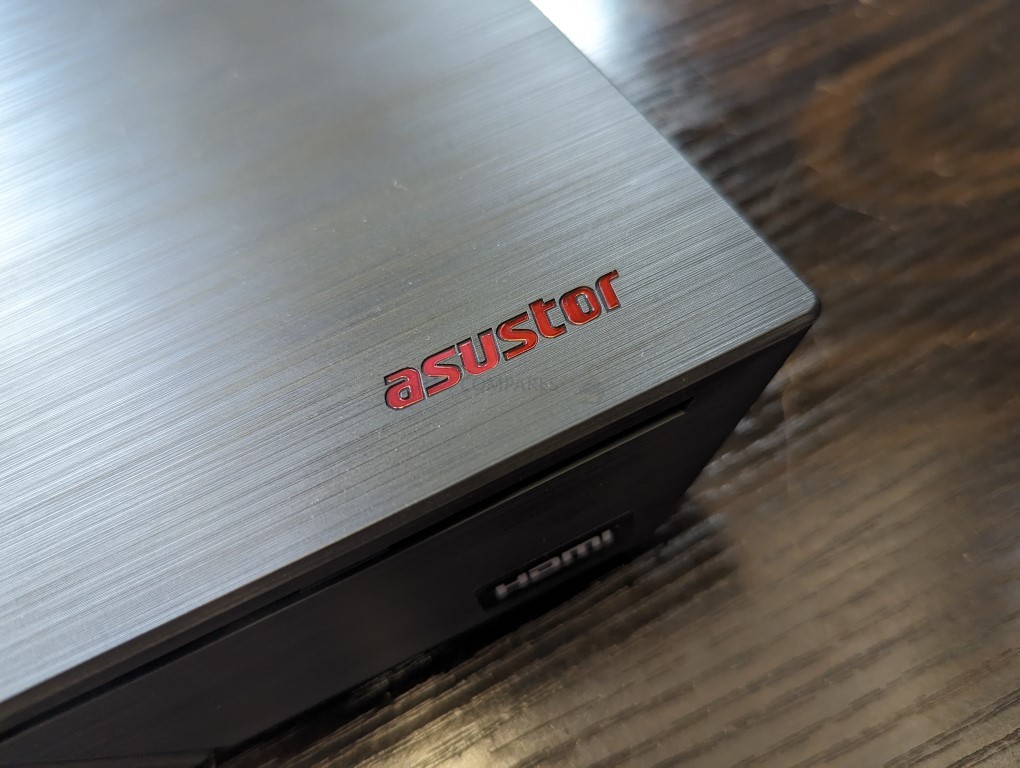
Asustor Flashstor 12 Pro FS6712X NAS Review – Quick Conclusion
I cannot stress enough how impressed I am that the Flashstor 6 and Flashstor 12 Pro are priced at $499 and $860, respectively, given the level of hardware on offer here. These are by no means enterprise-grade NAS server solutions, nor should they be thought of as such. However, given the cost of typical fully featured 4x HDD solutions from their competitors and the brand themselves, which often start at $550 and above, it is quite remarkable that the six M.2 SSD system with comparable internal hardware comes in at $499. As long as a user keeps their expectations in line with what this cost versus its capabilities, it’s really tough to argue with the price point that these two devices have arrived at on the market. The Asustor FS6712X Flashstor 12 Pro NAS presents a unique offering in the NAS market, leveraging NVMe technology to provide high-capacity, ultra-high-performance storage. The device’s design, with its rhombus-shaped enclosure and twelve M.2 NVMe slots, sets it apart from traditional NAS devices and offers a sleek and modern aesthetic. The tool-less drive installation mechanism makes it easy to set up and expand the storage capacity. However, there are some considerations to keep in mind. The limited number of PCIe lanes provided by the Intel Celeron N5105 processor may restrict the performance of high-speed NVMe drives. The single 10GbE LAN port also presents a potential network bottleneck, limiting the device’s overall network performance. Users seeking maximum performance and network throughput may find alternative solutions better suited to their needs. Despite these limitations, the FS6712X shines as a storage solution for users who prioritize high-capacity storage, quiet operation, and low power consumption. The device’s ability to directly output 4K video, along with its range of Asustor-approved apps, makes it an excellent choice for media distribution and presentation. In terms of pricing, the FS6712X comes with a price tag of $850+. While this may appear high at first glance, it is comparable to 8 bay drive NAS SATA devices and many of those do not even include NVMe slots or 10GbE. Users looking for a more cost-effective option can consider the Flashstor 6, which offers half the number of slots and 2x 2.5GbE enabled ports for $499. As the cost of flash modules continues to drop, and larger capacity drives become available all the way up to 8TB (even without QLC), the FS6712X provides an attractive solution for those seeking high-capacity and high-performance NAS storage. While some underlying performance relativity by the end user needs to be factored in and hardware limitations exist thanks to the use of that Celeron to remain budget-friendly, the FS6712X is a tremendously smart move by Asustor. A well-designed NAS that presents a much more confident solution demonstrating the benefits of NVMe-focused NAS devices to an audience that would have assumed such things are way, WAY outside the realms of affordability!
Where to Buy a Product





![]()
![]()

VISIT RETAILER ➤






![]()
![]()

VISIT RETAILER ➤






![]()
![]()

VISIT RETAILER ➤






![]()
![]()

VISIT RETAILER ➤
Asustor Flashstor 12 Pro FS6712X NAS Review – Packaging
Much like many other Asustor NAS products, the retail packaging for the Flashstor is colourful and graphical. This is a nice extra step, especially when you factor in that the bulk of buyers are going to purchase the device online (and therefore, that first look at the appealing packaging is going to be AFTER they have splashed the cash!). It’s some slick packaging that is certainly eye-catching!
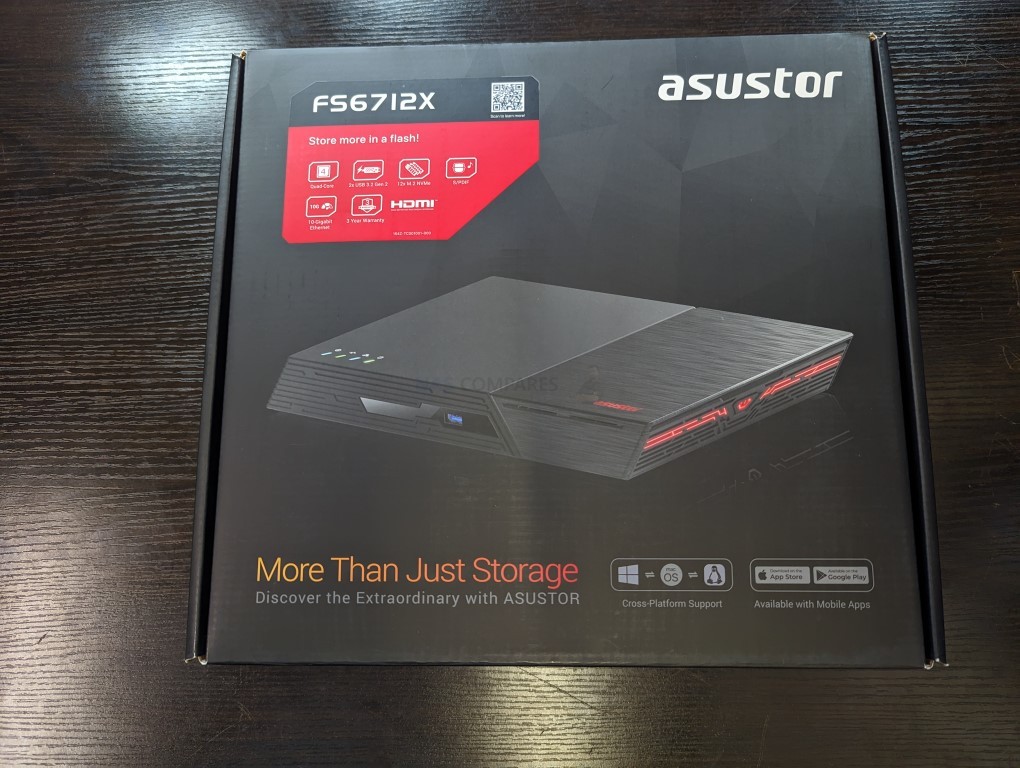
Opening it up, we find that the presentation of the contents hasn’t let it down either, with the system arriving in a fabric-esc sleeve and the accessories neatly packaged.
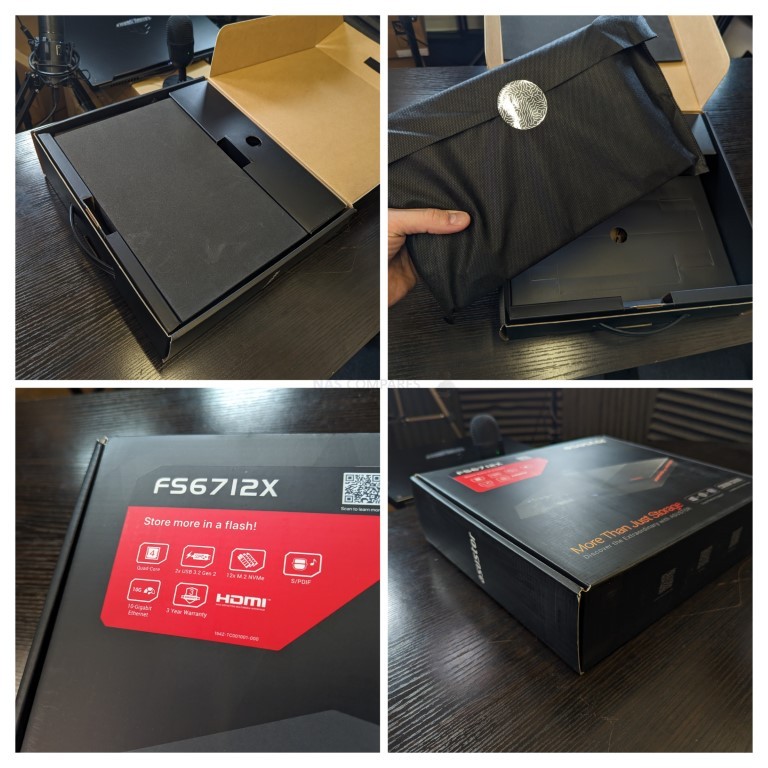
The full Flashstor 12 Pro FS6712X retail kit contains several items that allow you to deploy the device easily for the very first time. Everything you’re going to need is included here, apart from storage media, as the Flashstor 12 Pro is sold unpopulated. Asustor has always been in the practice of providing solutions without hard drives, so that end users can choose what media and to what extent they wish to populate their NAS on day one. This is, of course, a matter of taste and preference to the end-user, but generally, I always recommend unpopulated solutions, as it will allow you to plan your budget and spending requirements far more fitting to your requirements. The full list of accessories included with the device are:
- FS6712X NAS Unit
- CAT 5e LAN Cables
- External PSU (90W) and Mains Power Cable
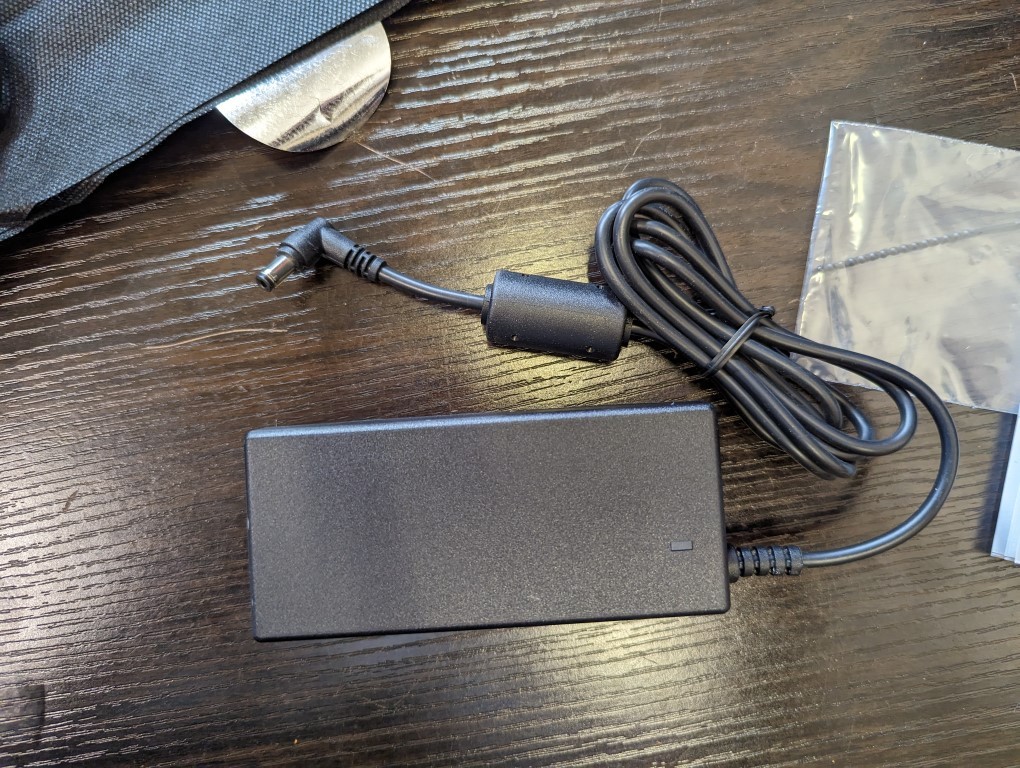
- Setup Guide and Warranty Details (3 Years)
- Power Cord Tie
All fairly standard stuff, but packaged very neatly.
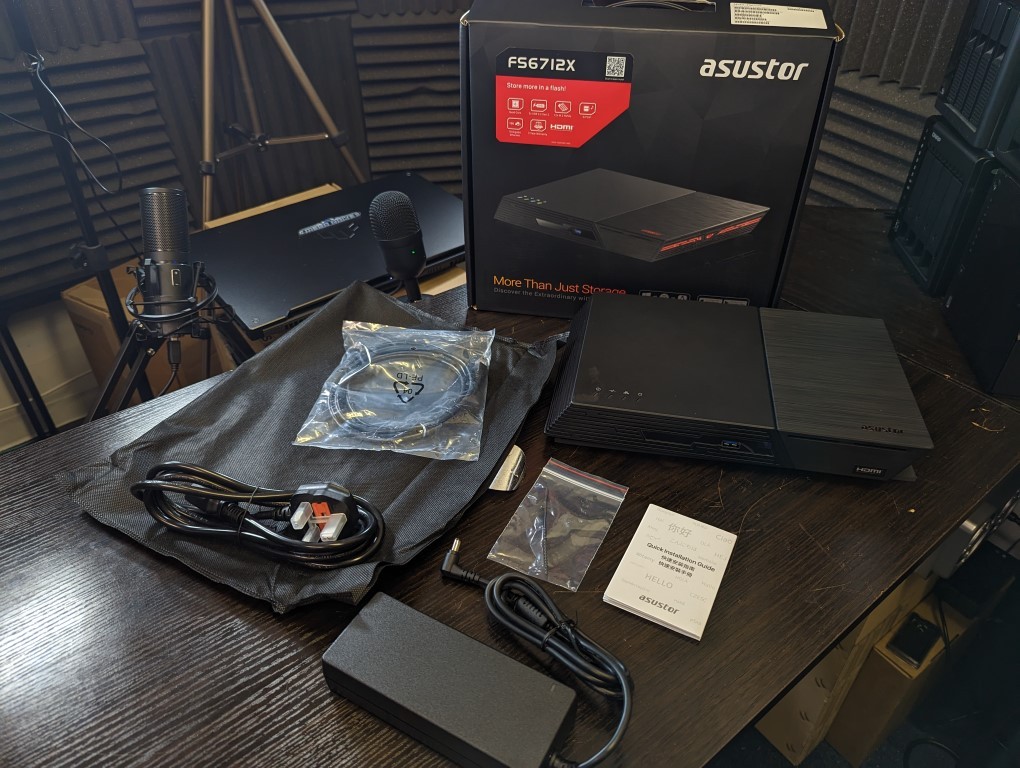
I am kinda surprised by the lack of heatsinks (something I raised in my original Before You Buy Video), but Asustor has addressed this question and was keen to highlight that because the lanes on the SSD slots are PCIe Gen 3×1, they should not have sufficient throughput to necessitate heatsinks. Going as far as to produce a temperature testing demonstration:
We will be conducting our own tests soon, looking at sustained use over longer periods to see the impact, but nevertheless, Asustor does make a compelling case. Let’s discuss the design of the Flashstor.
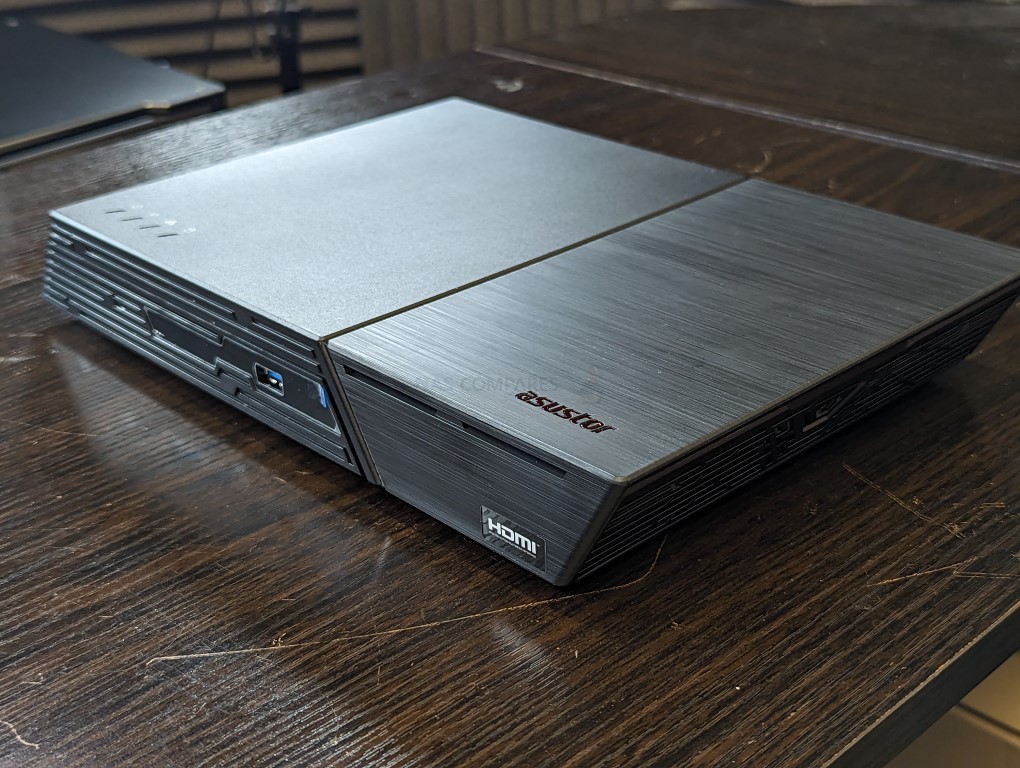
Asustor Flashstor 12 Pro FS6712X NAS Review – Design
The design of the system is quite ‘PS4’ ish, it has to be said. But it IS fantastically compact, considering the scale of storage available here. With 2280 M.2 NVMes now arriving in as high as 8TB capacity, this is a pretty substantial amount of storage in such as small server. The system has a single base-mounted fan, as well as numerous ventilation points all around the sides. As nice as it looks, is does feel a little cheap as they casing is completely plastic. Not unusual for a desktop NAS and certainly for this price tag, understandable.
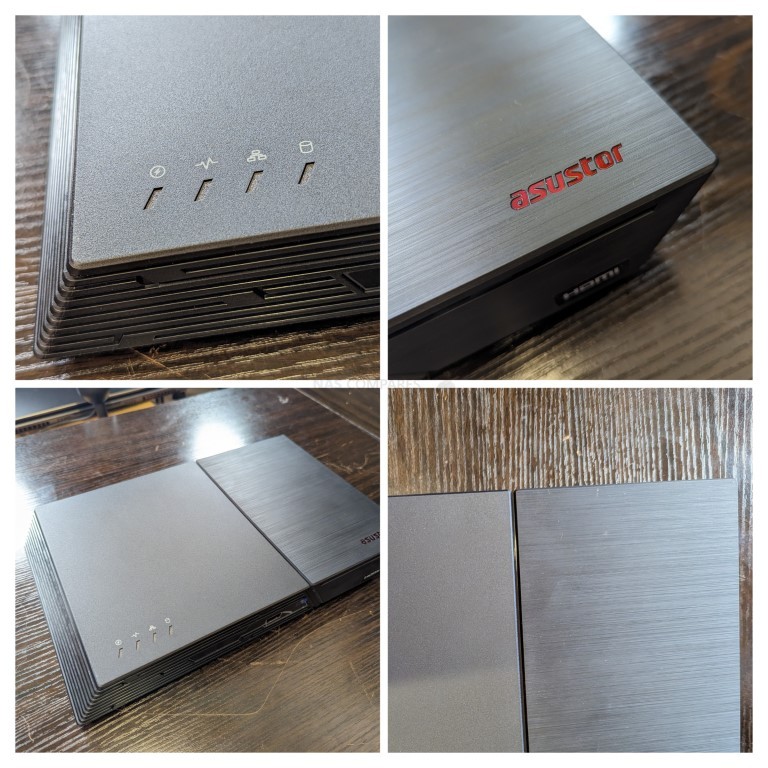
Either narrow end of the chassis is massively ventilated, with one backing onto the internal CPU+Heatsink and the other next to the storage media bays. There are also some subtle slits of ventilation on either side that are next to the m.2 NVMe SSD storage bays. The base-mounted fan is located directly over the storage media bays and is connected into the chassis in a sliding motion with a USB connector. It feels well constructed and although the fan itself is a fairly standard PC fan, I applaud the way it’s been utilized and installed here.
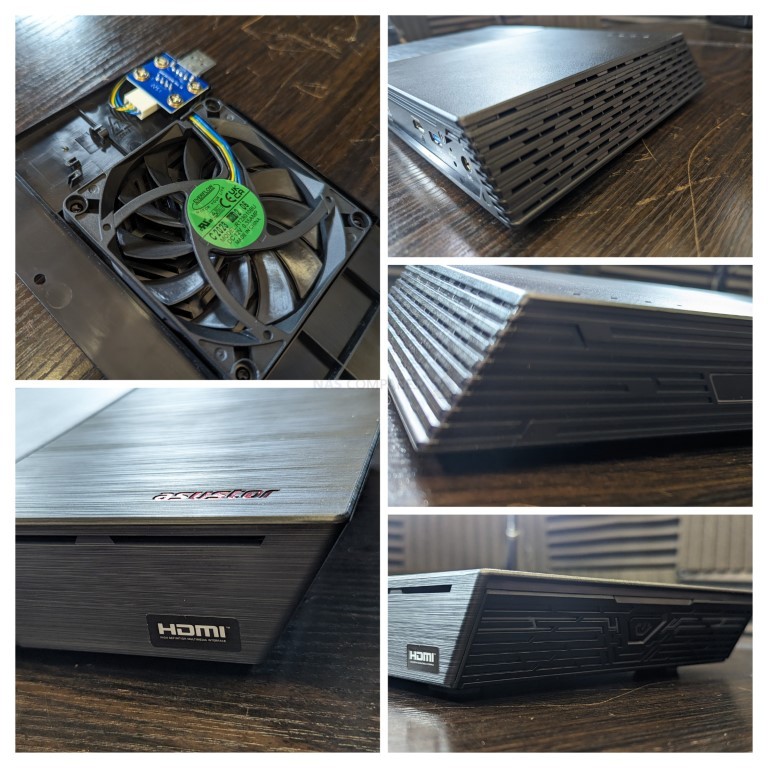
The top of the Flashstor comprises a two-tone finish, with a matt black panel on the left and brushed steel effect plastic on the panel above the M.2 NVMe SSD bays. The system also has four LEDs that denote system health, network connectivity, RAID Pool activity and system activity. Pretty much what you would expect and results in a very sleek and understated system when in operation.
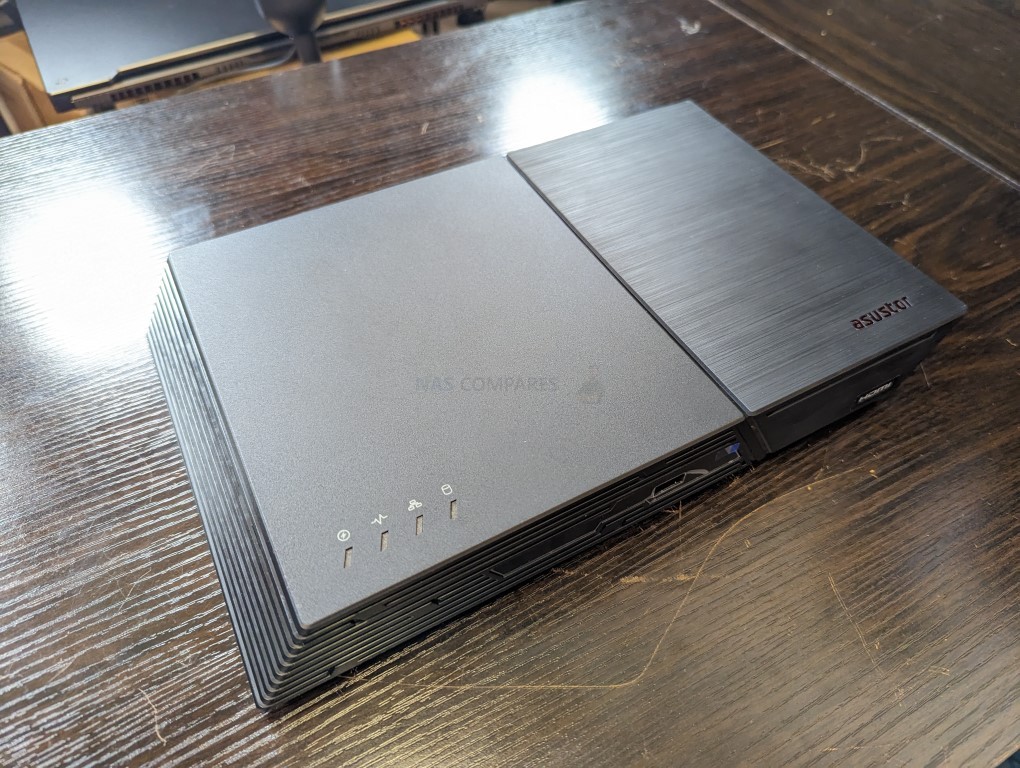
The base of the flash store shows us the four rubber feet that raise the system up by a few millimetres, but also that base fan. I do wonder about the effectiveness of this fan on the base of the system (though under the M.2 NVMe SSD media) as the other half of the system is comprised of one large heatsink that covers the CPU, which runs directly into the pathway of that fan, but also the M.2s. Again, we will run some test temps later on the YouTube channel.
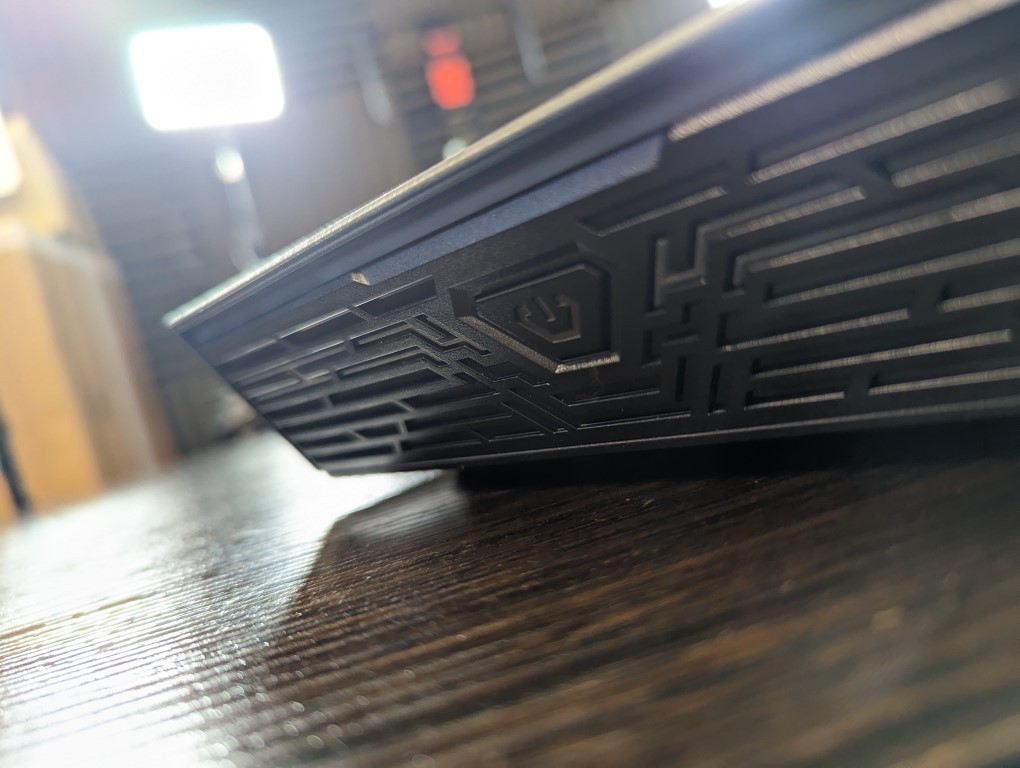
The design of the Asustor FS6712X Flashstor 12 Pro NAS is both unique and slightly unconventional. The rhombus-shaped enclosure, constructed mainly of plastic, sets it apart from traditional NAS devices. While some may find the design to be a matter of personal taste, others may appreciate the visual interest it brings to the table. One peculiar aspect of the design is the location of the power button. It is positioned on the right side of the unit, which can make it challenging to locate from above. This placement is not the most intuitive and may cause initial confusion for users. On a positive note, when the NAS is powered on, the side of the chassis lights up in a vibrant red, adding a cool visual element to the device.
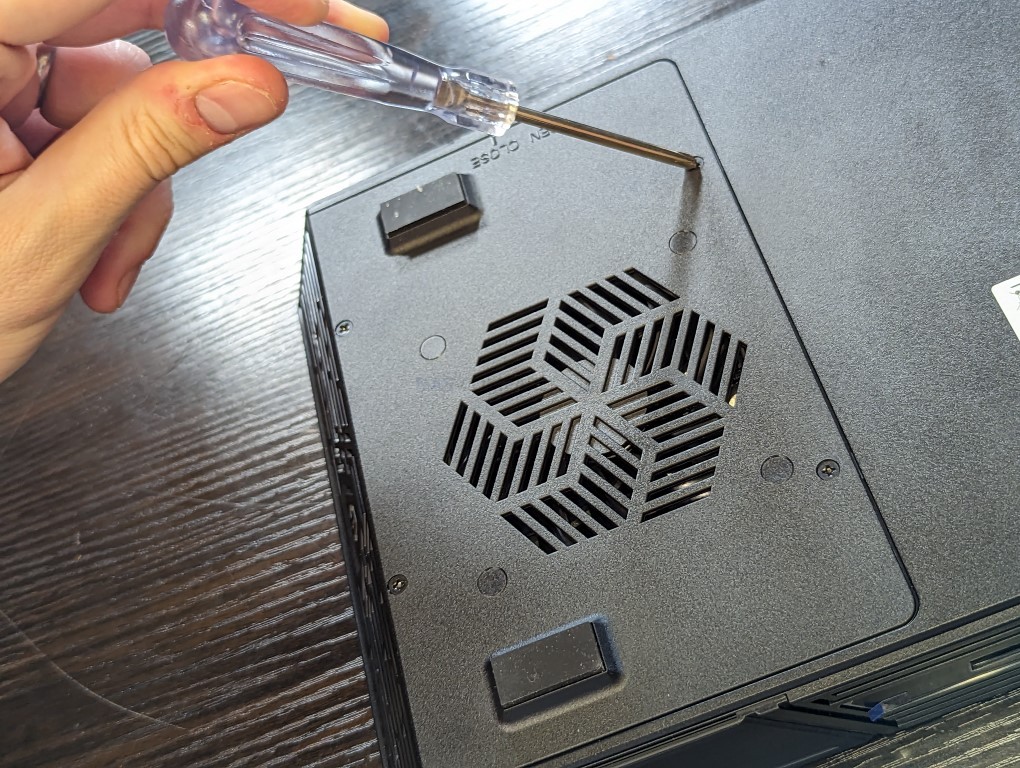
The removable panels on the enclosure provide convenient access to the twelve M.2 NVMe slots. Installing drives is a breeze, thanks to the plastic clip mechanism that holds the drives securely in place. Unlike some NAS devices that require tiny screws for drive installation, the FS6712X simplifies the process with its tool-less design.
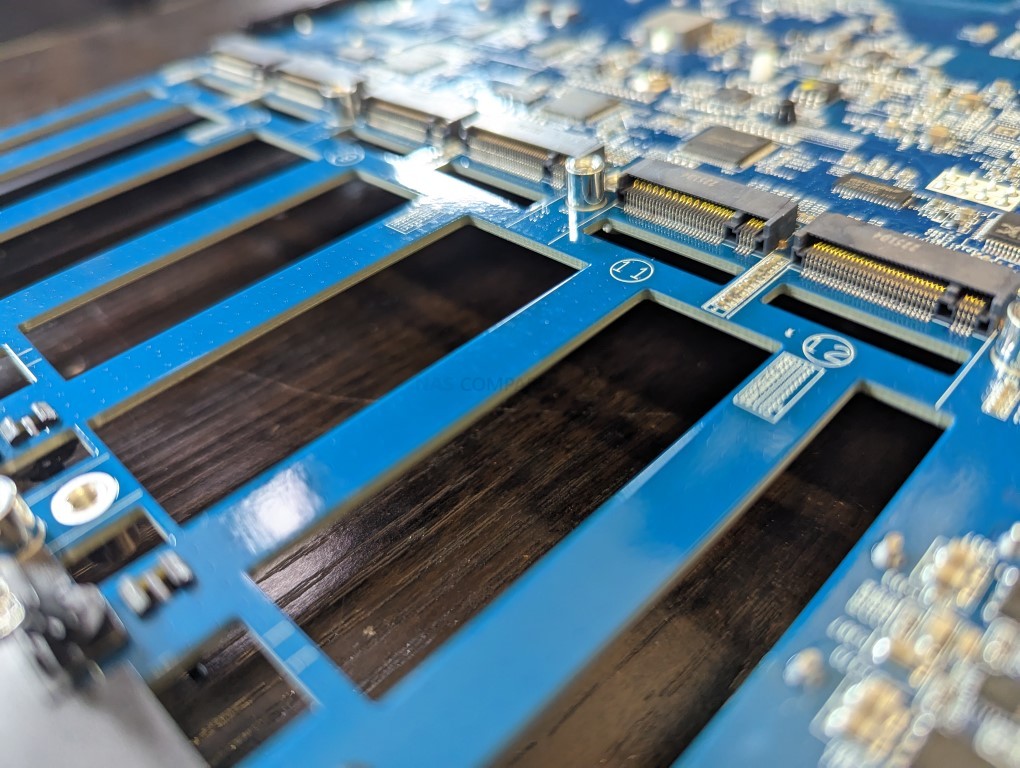
However, it’s worth noting that the slots only accommodate 2280-size modules, which may be a limitation for users looking to use smaller/larger form factor drives. That said, 2280 has largely become the defacto size available the bulk of M.2 SSDs on the market.

Overall in terms of build quality, the FS6712X could benefit from a more premium feel. The plastic enclosure, while functional, feels a little cheap. Thicker plastic or the use of metal (perhaps even to aid heat dissipation) would have enhanced the overall durability and sturdiness of the unit, but then we would be hitting the wall of this device’s price point significantly. Despite these minor design considerations, the FS6712X stands out with its distinctive shape and user-friendly drive installation mechanism. Let’s discuss the ports and connectivity.
Asustor Flashstor 12 Pro FS6712X NAS Review – Ports and Connections
The Asustor FS6712X Flashstor 12 Pro NAS offers a range of ports and connections, both typical and unique to NAS devices. At the rear of the unit, you’ll find the standard power and USB ports that are commonly found on NAS units. However, the FS6712X goes beyond the ordinary by providing additional ports typically associated with desktop computers. These include an HDMI port and an S/PDIF port, catering to users who seek media distribution and high-quality digital audio output.
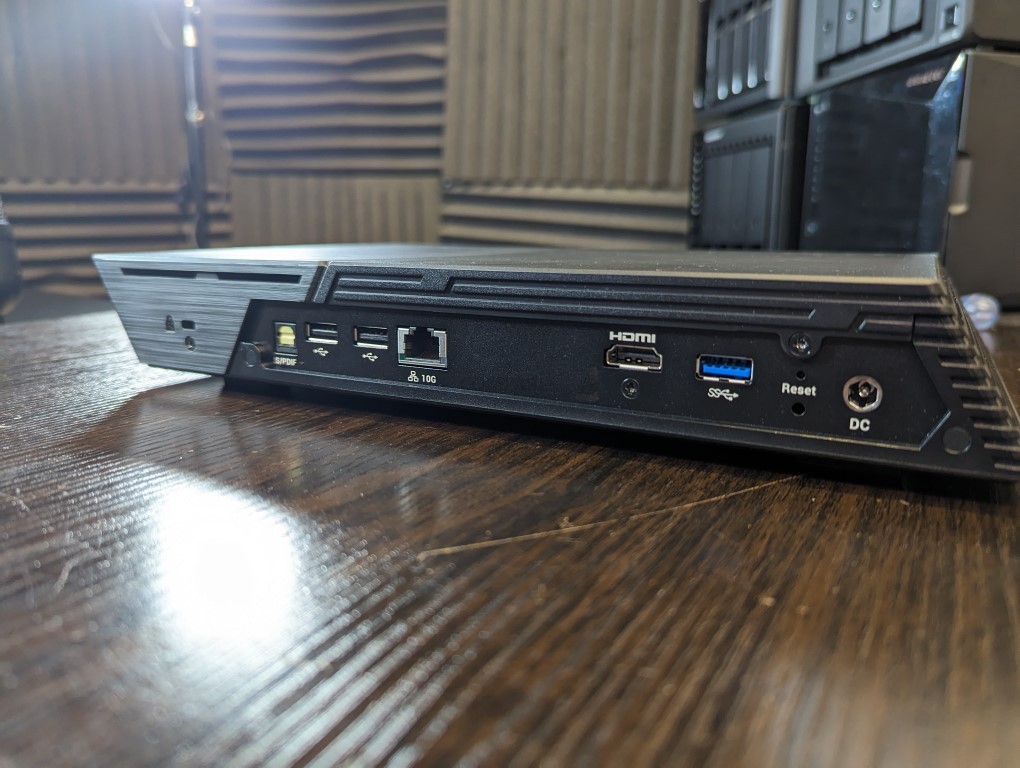
A notable feature of the FS6712X is its inclusion of a 10Gbase-T port 10G port. This high-speed networking capability allows for faster data transfer rates, which is especially beneficial for users working with large files or engaging in data-intensive tasks. The single 10GbE LAN port supports an existing 1GbE network connection or 2.5G too, so you still have flexibility if you are looking to gradually scale up your network environment at a later date with the Flashstor, providing flexibility based on the available network infrastructure. It is a shame that there is only one network connection (with most NAS devices that have 10GbE on port having a 2nd 1GbE port for failover, a traditional internet connection or lower priority connectivity. This is navigatable with a switch of course but it’s still a shame that we only have the single network connection here.
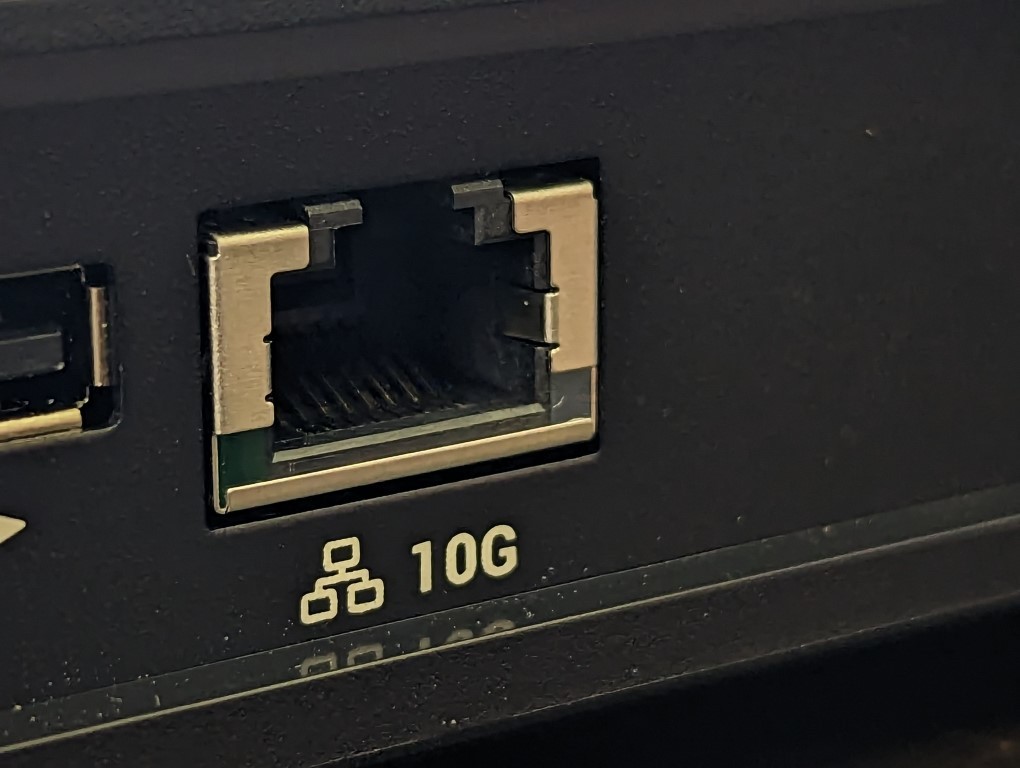
While the FS6712X offers a useful 10GbE LAN port, it also has 2x 10Gb USB connectivity (local accessories and peripherals) and probably one of the largest compatibility lists supported devices than any other brand – USB storage, Office hardware such as printers and scanners, UPS’, TV tuners, Network Adapters and more. Support of USB devices in recent years has decreased among many brands for fears of these being exploited for security workarounds, but % numbers on these are extraordinarily low and the threat actor would need direct access and a USB deliverable payload.
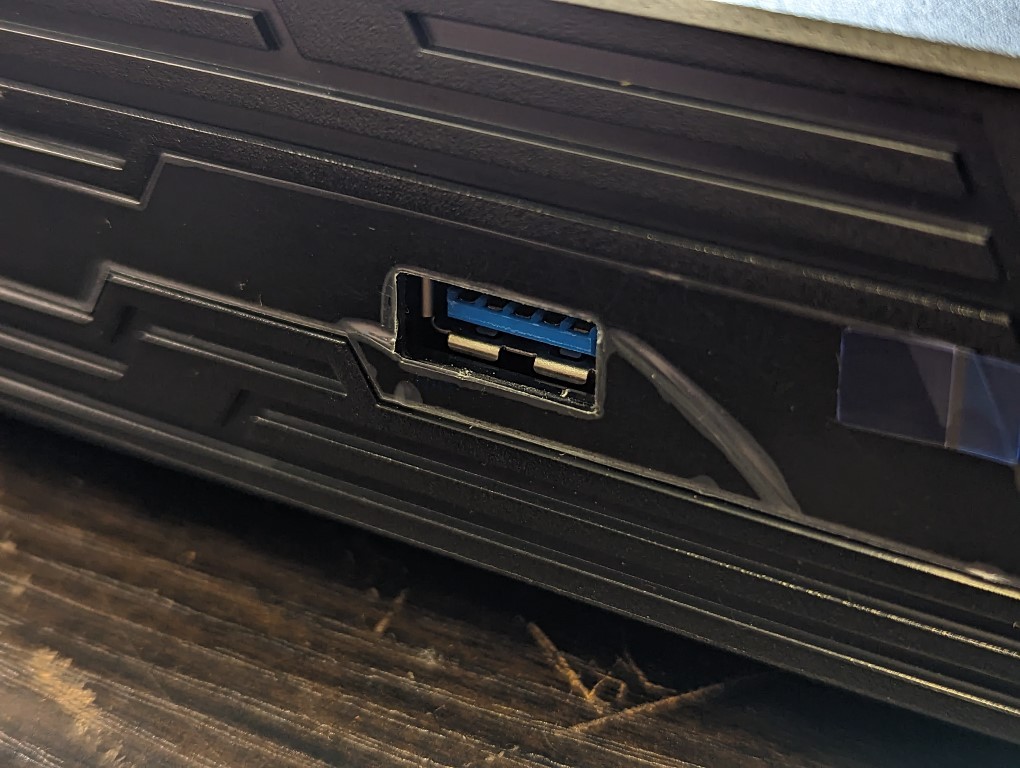
Again, not impossible, but at that point they are hands-on with the sever anyway and the potential for harm is already high! These USB ports are accompanied by a couple more USB 2.0 Ports, which are primarily included for local KVM accessories or just general low bandwidth controllable, in conjunction with the visual and audio outputs. And on that subject…
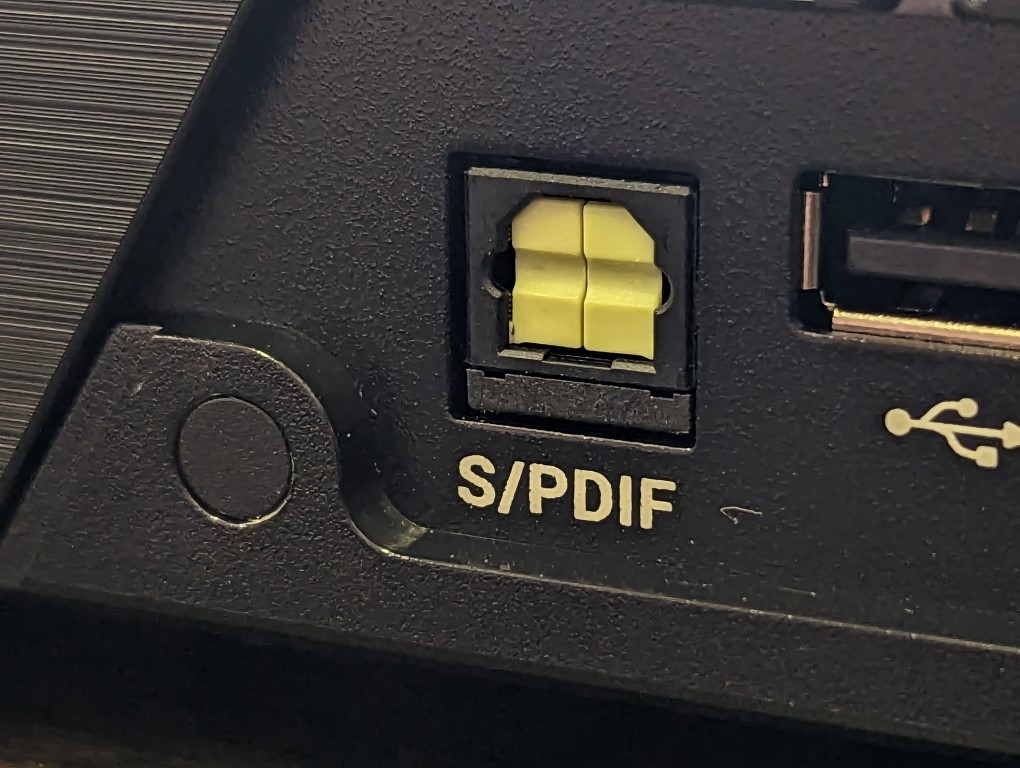
The general connectivity of this device, for its price point, is another area that left a positive impression on me when getting set for my review. Of course, there are USB ports for storage and accessories, two different network connection options, and then things get quite unique. Both of these devices arrive with not only HDMI 2.0B for increased visual bandwidth performance in 4K, but they also arrive with an SPDIF audio output. This is remarkably rare on network-attached storage devices and those looking to output high-end audio and dense audio format tracks directly into their expensive sound systems will appreciate the enhanced audio and visual connectivity on the Flashstor.
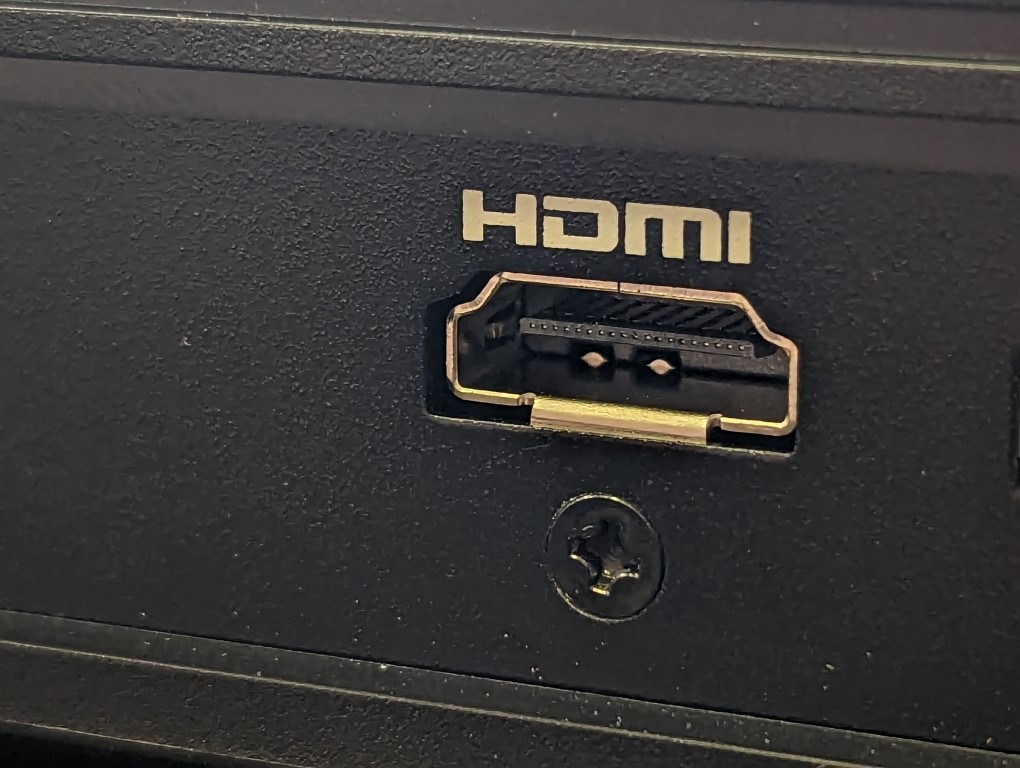
This is still arguably a niche for audio output, but there are certainly users who will be thrilled about this. The HDMI output is utilized with Asustor’s portal application, a complete parallel graphical user interface to access the NAS. It provides a full HDMI user interface that can be controlled via infrared remote control, network remote control, or just a simple USB keyboard and mouse. There are hundreds of available applications and services that can run via this HDMI output, allowing you to run a vast number of local multimedia and business services directly from the device. These range from first-party tools for surveillance and streaming 4K media, to third-party applications for connecting streaming subscription services and virtual machines. Additionally, this system also features an HDMI dedicated parallel GUI, called Asustor portal. This separate user interface and means to interact with the data on your NAS in a far more graphical level is something currently only QNAP provides. The visual out used in conjunction with the two additional USB 3.2/2.0 ports opens up numerous KVM (or keyboard video mouse) applications, such as a stand-alone surveillance system, a stand-alone desktop computer used in conjunction with the virtual machine software, direct output of your movies and box sets from your collection, a retro arcade machine with support for controllers and numerous other first and third-party software options.
Additionally, the Flashstor 12 Pro has scaled things up over the previous model by adding HDMI 2.0b, which is a 4K 60 frames per second visual output, but also is much more efficient at handling HDR and SDR using available bandwidth. That means that you will be able to enjoy particularly dense 4K top-end media with close to zero playback and browsing latency time, by connecting the NAS directly to your TV, as opposed to streaming such large media over the network.
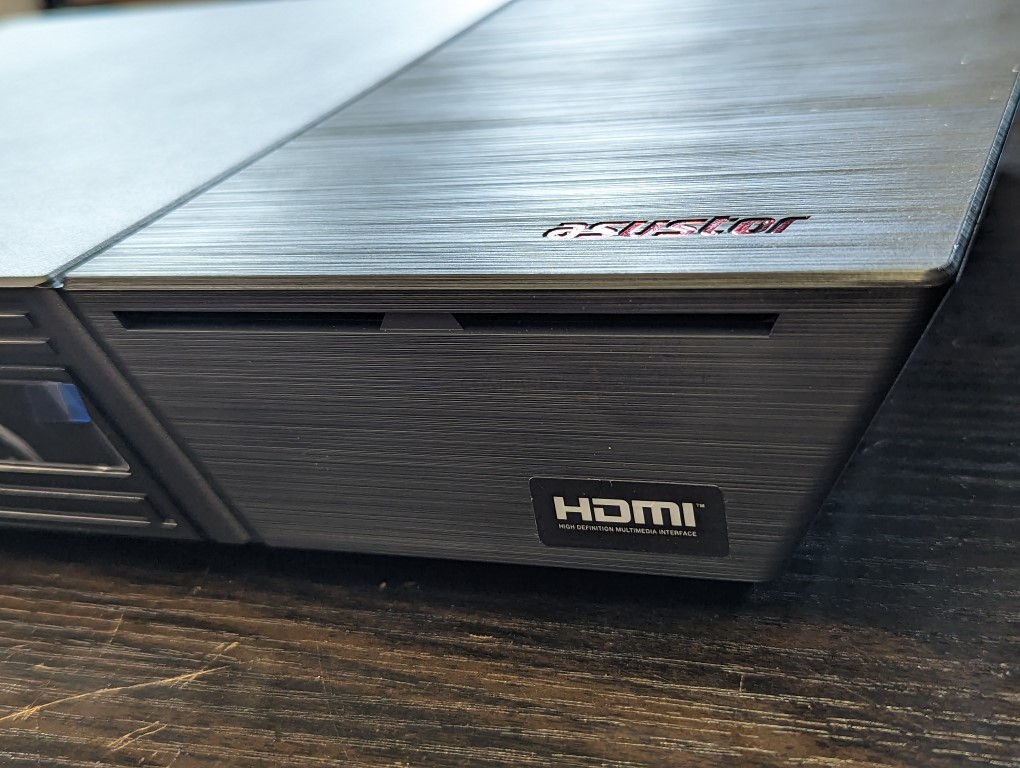
Overall, the FS6712X provides a decent selection of ports and connections, although the absence of USB 3.2 Gen 2 support is a minor drawback that may affect external storage performance. Let’s discuss the internal hardware.
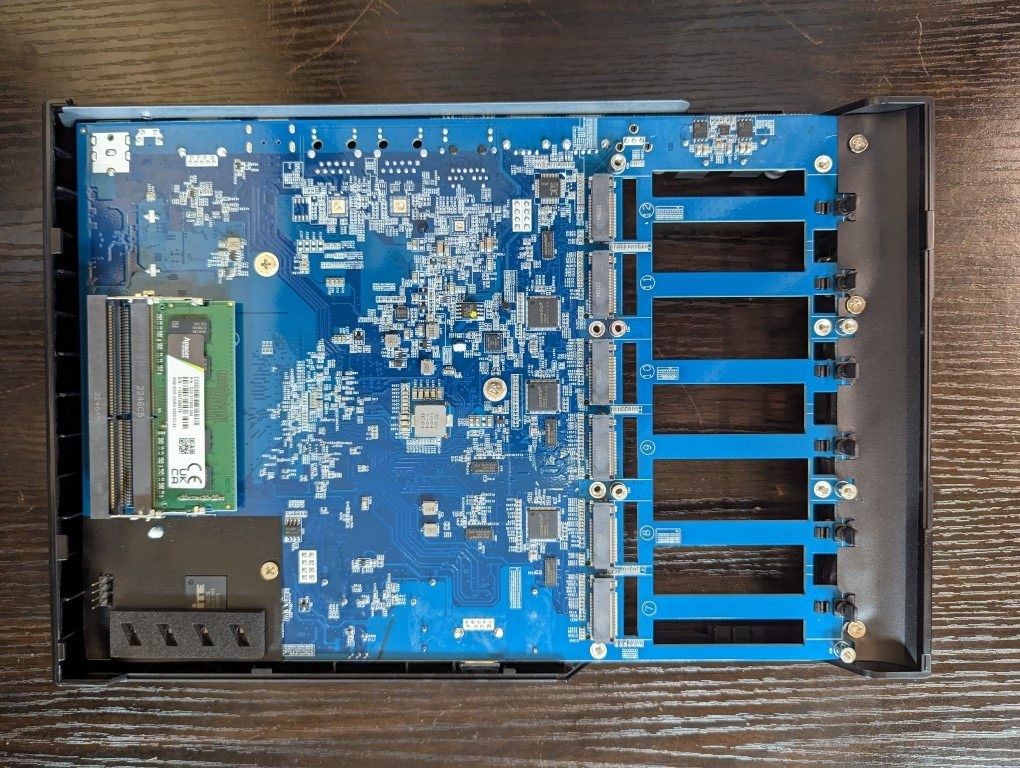
Asustor Flashstor 12 Pro FS6712X NAS Review – Internal Hardware
The internal hardware of the Asustor FS6712X Flashstor 12 Pro NAS is a mix of impressive capabilities and potential limitations. The device is built around the Intel Celeron N5105 processor, a quad-core Jasper Lake CPU known for its power efficiency. This choice of processor strikes a balance between performance and heat generation, making it suitable for NAS applications. Also we have seen extensive use of this processor in the last 18 months but many brands (including asustor themselves in the Lockerstor and Nimbustor Gen 2 series.
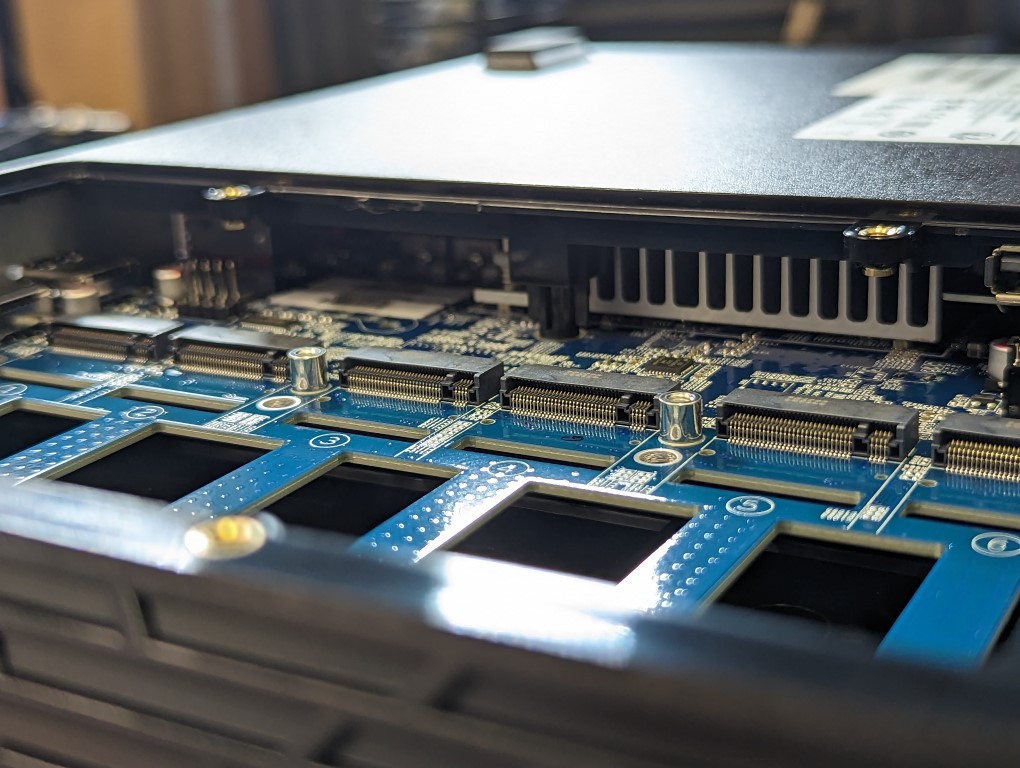
This processor has a reasonable 2.0-2.9Ghz performance level, 4 Core/4-thread architecture and integrated graphics which (although not as impressive as a dedicated GFX card or integrated GFX of the likes of an Intel Core) are going to be remarkably handy for tasks such as Plex Media Server conversions, handling heavier surveillance feeds in HEVC or even more graphically stretched containers/VMs. This CPU does however present limitations in the sheer breadth of its PCI lanes and scope to how much use you can put it into, but more on that in a bit. At this price point though, this CPU makes a lot of sense, especially when you factor in that the 6 Bay Flashstor is similar/lower in price to most comparable HDD NAS 4-Bays from Synology/QNAP and the 12 Bay Pro version is 10GbE and lower in price than most 8xHDD NAS Systems of Intel Celeron build.
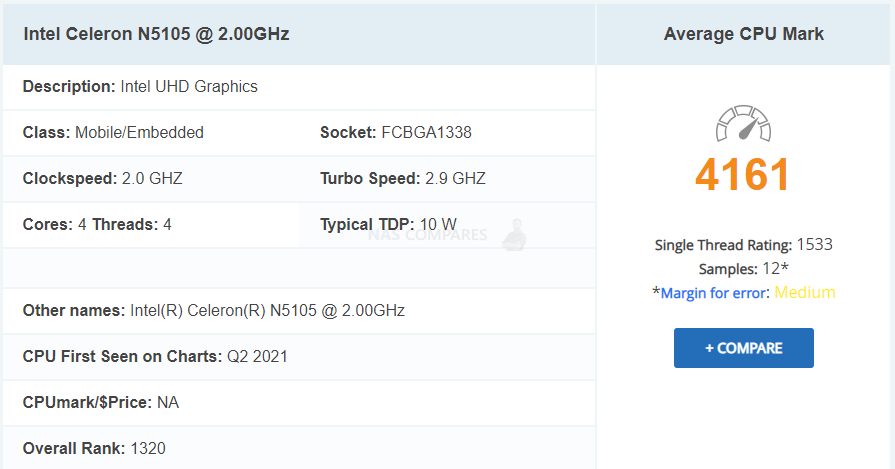
In terms of memory, the FS6712X comes with 4GB of DDR4 memory as standard (both the 6 and 12 Bay arrive with 4GB by default), which can be expanded up to 16GB. While 4GB may be sufficient for basic NAS functionality, users with more demanding workloads or resource-intensive applications may benefit from upgrading the RAM. The expandability provides flexibility to accommodate varying needs and workloads, especially when you factor in that the Half price 6-Bay has the same memory quantity, but the 12 Bay has 12 NVMes to run AND that 10GbE port. That means that the Flashstor 12 Pro pretty much immediately needs that memory scaled up to at least 8GB if you want to run even a handful of the main services/applications of the FS6712X.
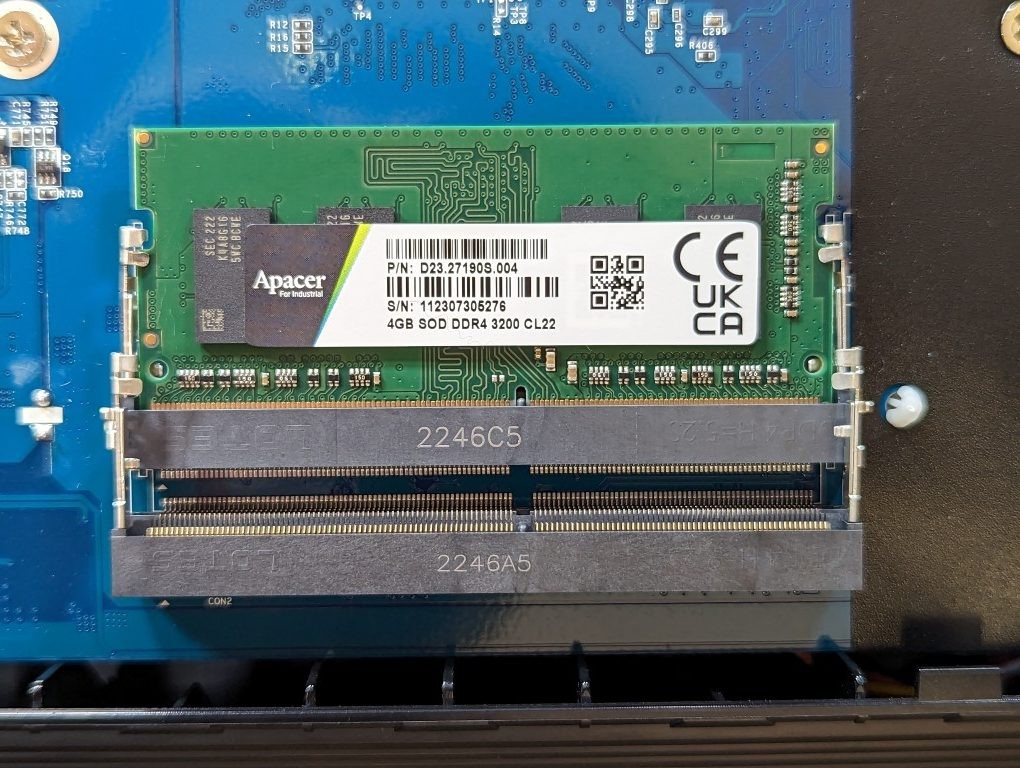
The most noteworthy aspect of the internal hardware is the storage configuration. The FS6712X supports twelve M.2 NVMe slots, allowing for a significant storage capacity. With the ability to accept 2280 PCIe M.2 NVMe modules, the device can potentially house up to 48TB of storage, with the potential to double that capacity when 8TB modules become widely available,peaking at 96TB. There are also several official expansion devices supported (only SATA drives), with even a new 4-Bay 10Gb USB-supported Asustor expansion device available (the AS5004U).
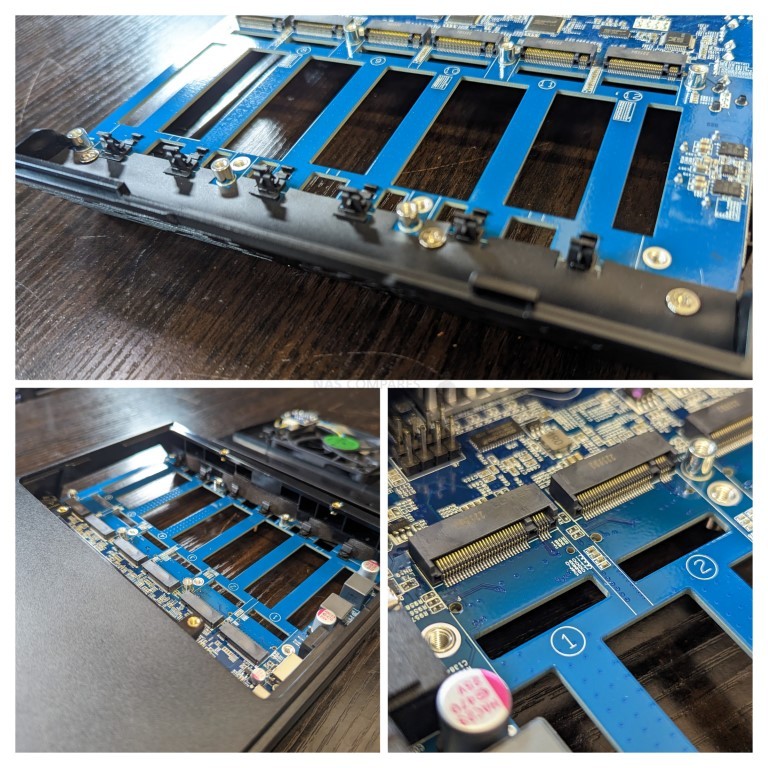
However, it’s important to note that the device’s internal architecture presents some limitations. The Intel Celeron N5105 processor offers a maximum of eight PCIe lanes, which falls short considering the number of M.2 slots and other connectivity options available. This is mitigated by a PCIe bridge chip, but ultimately results in each NVMe SSD slot capping at PCIe Gen 3×1 – so a theoretical maximum of 1,000MB/s per drive, which still won’t be realized in a larger RAID (particularly in Write performance) duue to that efficient little chip just not having the muscles.
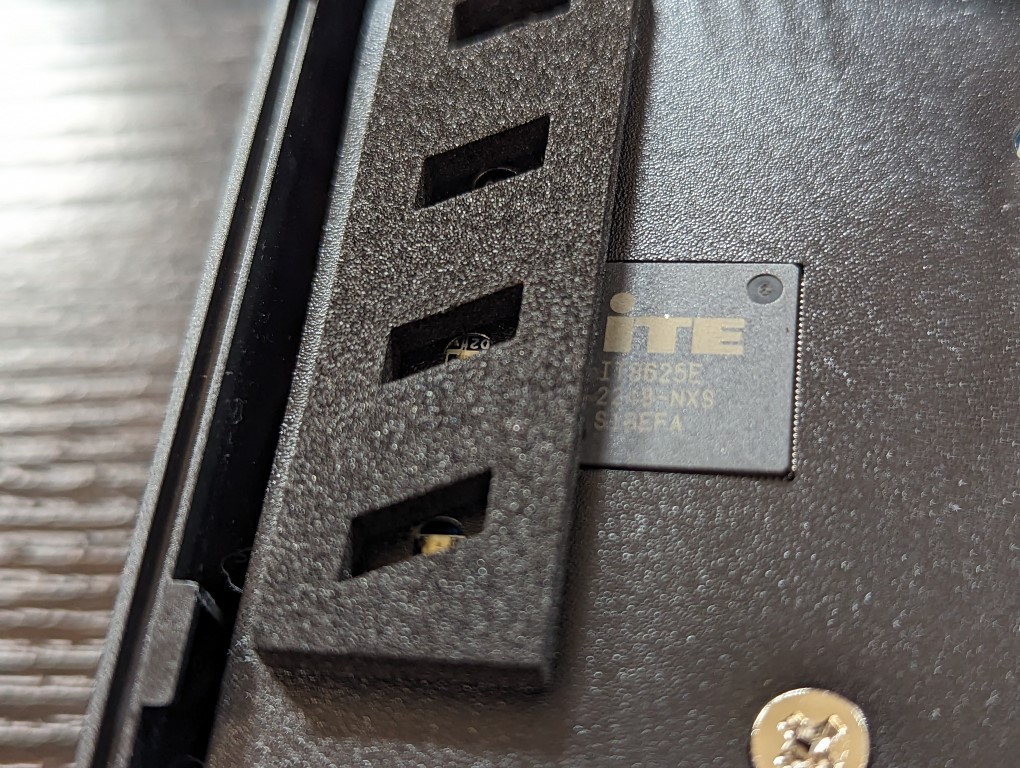
This constraint means that each M.2 slot only receives a portion of the bandwidth, potentially limiting the performance of high-speed NVMe drives, with most users most likely utilizing PCIe Gen 3×4 SSDs. This has to be taking in with a pinch of salt, as you need to remain relative to the cost of this device. If you want a full-guns-blazing-flash-NVMe-limitless-server, you would need to spend a few thousand on a Xeon system with the PCI lanes and memory potential to realize it. At $499 for the 6-Bay and a pinch over $850 for the 12 Bay, the performance here is exceedingly relative to the price tag!
Despite these limitations, the FS6712X provides an excellent platform for high-capacity storage with the potential for future expansion. The choice of components strikes a balance between performance and power efficiency, making it a suitable option for a wide range of users. As long as you keep the hardware and price tag in perspective, you are looking at a very reasonable flash system here and easily one of the best entry points into owning your own flash NAS server.
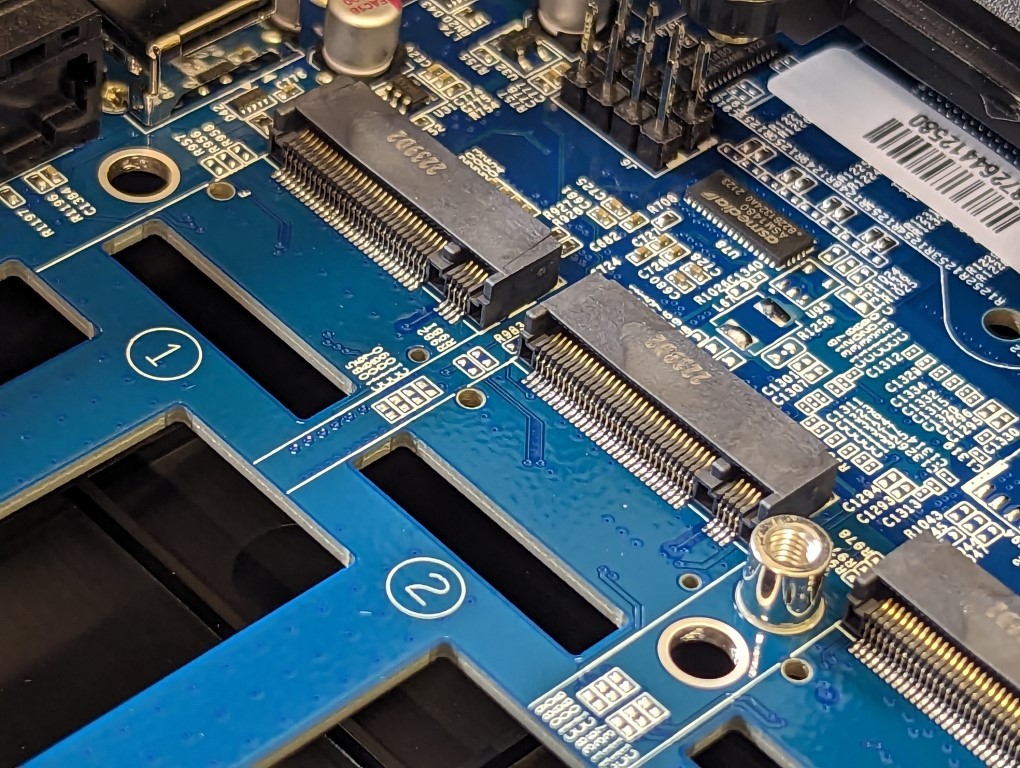
Asustor Flashstor 12 Pro FS6712X NAS Review – Software
The Asustor FS6712X NAS arrives with the latest version of ADM included. Additionally, this software receives frequent updates to ensure that the software runs the very best it can on the Flashstor, as well as keeping up to date with security patches and application versions. The NAS software is accessible via a web browser and displayed very much like a normal computer operating system (desktop, user accounts, customizable themes, file management, running multiple tasks in windows that can be switched in the native tabs), but there are also a range of desktop client tools for accessing the NAS on your local machine natively, as well as a whole bunch of mobile applications that allow tailored access from your phone/tablet in more task-specific means (eg a photo app for viewing pictures and creating phone backup routines, a video app for enjoying your movies and boxsets, surveillance app to access your cameras, etc). There is also a large range of support of 3rd party applications too in the ADM platform. Asustor is not as big a company as the likes of Synology and QNAP, whole put ALOT more money into their software development, but Asustor try to counter this by (when they do not have an in-house app) making native versions of 3rd party tools in their platform (example, they do not have a 1st party Virtual Machine app, but DO include huge support for VirtualBox). The platform is not quite as fully featured as DSM and QTS, but it is still a very smooth and accessible software platform. The app center has a few more 3rd party applications and slightly crowbarred software (eg the Amazon Media and Streaming service plugins) that is not updated up the original uploaders anywhere near enough (leading to running issues on these tools), but the 1st party apps run very well. The big takeaway on the Asustor software and it’s services is that the standard class of expected features of a modern NAS in 2023/2024 are here and run exactly as you would want, it is just some of the additional ones that other platforms have doubled down on (such as AI-related services in Photography and Surveillance for example) that are a little lacking. That said, the brand has definitely ramped up a number of the key security protocols and settings in the default setup.
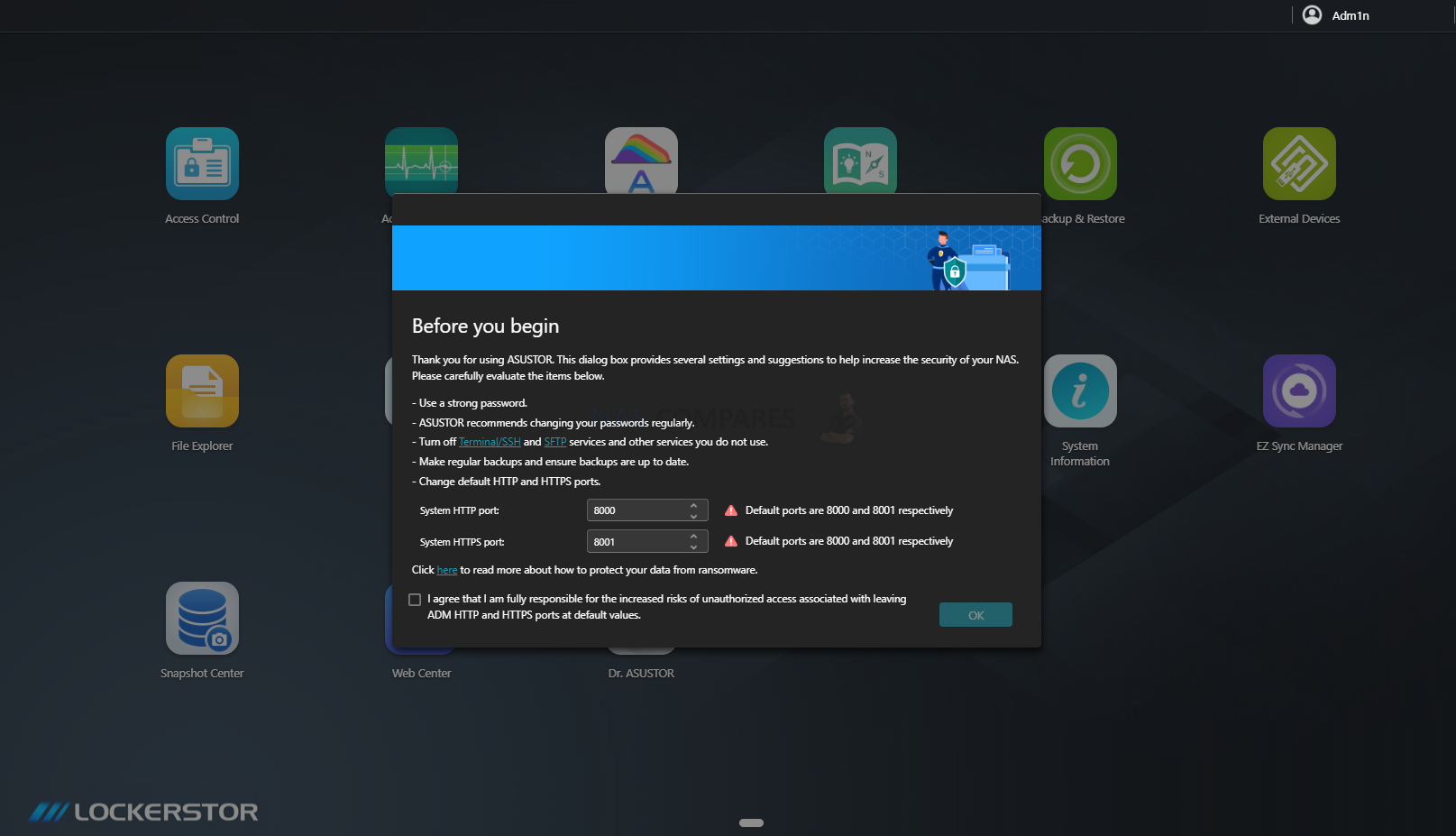
LooksGood Media App – Built-in three main video library categories; movies, TV shows, home movies and smart video sorting management
-
- The efficient global search function allows for searches by keywords followed by the execution of more detailed searches for the purpose of finding categories of movies, TV shows, home movies and parameters such as actors, director, year, genre, writer and title
- Attractive poster wall and thumbnail display
- Automatic production of video poster thumbnails
- Centralized management and ability to configure the order of favourites and playlist history
- The system administrator is able to configure video library and editing permissions according to user preferences
- Can configure access permissions to share with
- Multimedia conversion feature
- Self-defined smart folder for video conversions
- Supports digital TV recordings via digital
- Easy streaming with Chromecast and DLNA
- Supports playback of videos in Apple TV via AiVideos tvOS version
Plex – Hardware Transcoding (with a Plex Pass) is likely and with 1080p handled very well indeed, as well as some Plex 4K transcoding in H.265 (upto 60-80Mb bitrate) and the majority of H.264 Media upto 100Mb bitrate
Virtual Machines – A graphical embedded CPU like the one here will run Windows 10 and Android VMs very well. With the added support for Ubuntu and Hackintosh with VirtualBox. Then there is the option to scale up that memory to allow smoother VMs
Storage Management – BTRFS Support, as well as EXT4 for the traditionalist, Multiple Snapshot storage and browsing for recovery, a large number of ISCSI and LUN target creation, fast-acting SSD caching use. Remember that those M.2 NVMe SSD Bays can be used as both raw Pools and Caching
Network Management – Support of LAG, Load Balancing and virtual switches, as well as maintaining top transmission over 2.5/5/10Gbe for editing or gaming over the network. As well as Jumbo Frame control, DDNS automation, Wake on LAN support and internet/external NAS access with EZ Connect
Backups – Supporting a wide range of multi-tiered backup options that can be carried out simultaneously thanks to the powerful CPU in the Flashstor and Nimbustor NAS systems, such as network RSync, USB Backups, NAS-2-NAS migration, Cloud Backups with Google Drive, Dropbox and Backblaze and numerous RAID levels internally for redundancy.
Content Management – Numerous Content Management Systems (CMS) and Customer Relationship Managers (CRMs) available in 1st and 3rd party forms, with simultaneous operations supported by this NAS
User Account Control – Supporting over 4,000 accounts, each with its own bespoke privileges and access levels, as well as grouping methods to automate the process easily
Security – AES 256bit hardware encryption on data in/out of the device, as well as over backup methods, with the Intel Celeron CPU in the FS6712X maintaining high R/W speeds throughout, as well as Windows ACL permission and configuration, auto blacklisting and multiple VPN provider support
Antivirus (ClamAV) – Scheduled Scans, Automatic Virus Definition Updates, Quarantine Infected Files
Download Center – Supports BT(Torrent & Magnet Link), HTTP and FTP Downloads, Torrent Search, Bandwidth Control, RSS Subscription and Automatic Downloading (Broadcatching), ASUSTOR Download Assistant for Windows & Mac
DropBox, OneDrive and Google Drive Sync – Each ADM Account is Able to Individually Log into one cloud Account, supporting Sync, Directly Upload Files to cloud from the NAS, or from cloud to NAS
Mail Server – Each ADM Account can Become an Independent Email Account, Provides SMTP, IMAP and POP3 Mail Protocols, Spam Filter and Black List Settings, Antivirus Scanning for Emails, Exclusive Email Backup Mechanism, Auto-Forwarding and Auto-Response Protocols
Photo Gallary – “Album” and “Browse” Viewing Modes, Manage Photo Album Access Rights: Public Access, Restricted to Certain Accounts, Album Password, Multi-level Folder Structure Support, Supports Tagging of Photos, One-click Sharing to Social Media (Facebook, Google+, Twitter, Plurk, email), Intuitive Drag and Drop Management, Slideshow Viewing Mode, Supports a Wide Range of Image Formats: JPG/JPEG, GIF, PNG, BMP, TIFF, RAW and Supports Video Playback
Surveillance Center – Up to 64 channels in 720p on single live view display, On-screen camera controls including camera PTZ, manual recordings, take snapshots, configure camera settings and open Maps, Up to 4 channels of synchronous and non-synchronous playback with audio, Intelligent video analytics including motion detection and foreign object detection, Supported Browsers: Windows Internet Explorer, Microsoft Edge, Firefox, Mac Safari, Mac Firefox ESR, Event notification supports SMS, E-mail, and mobile push notification, AiSecure mobile app for iOS and Android with Push notification, Maximum IP Cam (4 Free Licenses; Additional Licenses to be Purchased)
Takeasy – Download from YouTube, Vimeo, Twitch and More, Selectable Video Type and Quality, Automatic Downloads with YouTube or Twitch Subscriptions, Preview Downloads in Progress and Online Playback
SoundsGood Audio App – Import Personal/Public Music Collection, Personal/Public Music Collection Permission Control, Playlist Editor, ID3 Tag Editor, Local Speaker Support: HDMI, USB, Audio Jack, Supported Audio Formats for Browser: MP3, WAV, Ogg, Supported Audio Formats for Transcoding Through Browser: AIFF, Flac, Supported Audio Formats for Local Speaker: MP3, WAV, Ogg, AIFF, Flac
Backup Tools – Rsync (Remote Sync) Backup, Cloud Backup, FTP Backup, External Backup, One-Touch Backup, EZ Sync, Btrfs Snapshots
The Asustor FS6712X Flashstor 12 Pro NAS runs the Asustor NAS operating system, ADM 4.2. ADM offers a user-friendly web management interface that is intuitive and accessible. While it may not have as many wizards as some competing NAS systems, it strikes a balance between simplicity and functionality, making it suitable for both novice and experienced users.
One of the notable strengths of the software is the wide range of Asustor-approved apps available. Users can take advantage of various applications for tasks such as media distribution and presentation, thanks to the FS6712X’s capability to directly output 4K video through the HDMI port and the Asustor Portal interface. The inclusion of an S/PDIF port further enhances the device’s ability to cater to high-quality digital audio needs. Additionally, ADM supports multiple internal and external file systems, including Btrfs, EXT4, NTFS, FAT32, HFS+, and ExFAT. This flexibility allows users to work with various file systems and ensures compatibility with different storage devices and operating systems.
While the FS6712X offers a solid software experience with the Asustor NAS operating system, it’s worth noting that the software does not differentiate between the NVMe storage and other drive mechanisms. This means that the performance of the NVMe drives may not be fully utilized over the network. However, if the NAS is primarily used for indexing data directly or for local access, it can take advantage of the interactions between the Intel Celeron N5105 processor and the drive array, resulting in improved performance.
Asustor Flashstor 12 Pro FS6712X NAS Review – Benchmarks
Currently, we are working on a dedicated video benchmarking the Asustor Flashstor 6 and Flashstor 12 Pro with range of different RAID configurations and SSDs (as well as temperature testing). However, between RAID builds and sourcing the M.2 SSD media, this is taking longer than expected. These dedicated performance/system running tests should be live in the next week or so, but in the meantime below are a few early results from initial performance testing with a RAID 5 of half the available bays. We were hitting 1674MB/s (333291 4K Random IO/s) seq Read and 885MB/s (176919 4K Random IO/s) Seq Write. However, this was with small cap Gen3 drives that were not on the compatibility list of the system (that doesn’t;t mean they are not usable, just that Asustor had not verified them yet and there are literally hundreds of thousands of different SSDs in the market). We will be running tests with more established SSDs soon.
Asustor Flashstor 12 Pro FS6712X NAS Review – Conclusion
I cannot stress enough how impressed I am that the Flashstor 6 and Flashstor 12 Pro are priced at $499 and $860, respectively, given the level of hardware on offer here. These are by no means enterprise-grade NAS server solutions, nor should they be thought of as such. However, given the cost of typical fully featured 4x HDD solutions from their competitors and the brand themselves, which often start at $550 and above, it is quite remarkable that the six M.2 SSD system with comparable internal hardware comes in at $499. As long as a user keeps their expectations in line with what this cost versus its capabilities, it’s really tough to argue with the price point that these two devices have arrived at on the market. The Asustor FS6712X Flashstor 12 Pro NAS presents a unique offering in the NAS market, leveraging NVMe technology to provide high-capacity, ultra-high-performance storage. The device’s design, with its rhombus-shaped enclosure and twelve M.2 NVMe slots, sets it apart from traditional NAS devices and offers a sleek and modern aesthetic. The tool-less drive installation mechanism makes it easy to set up and expand the storage capacity. However, there are some considerations to keep in mind.
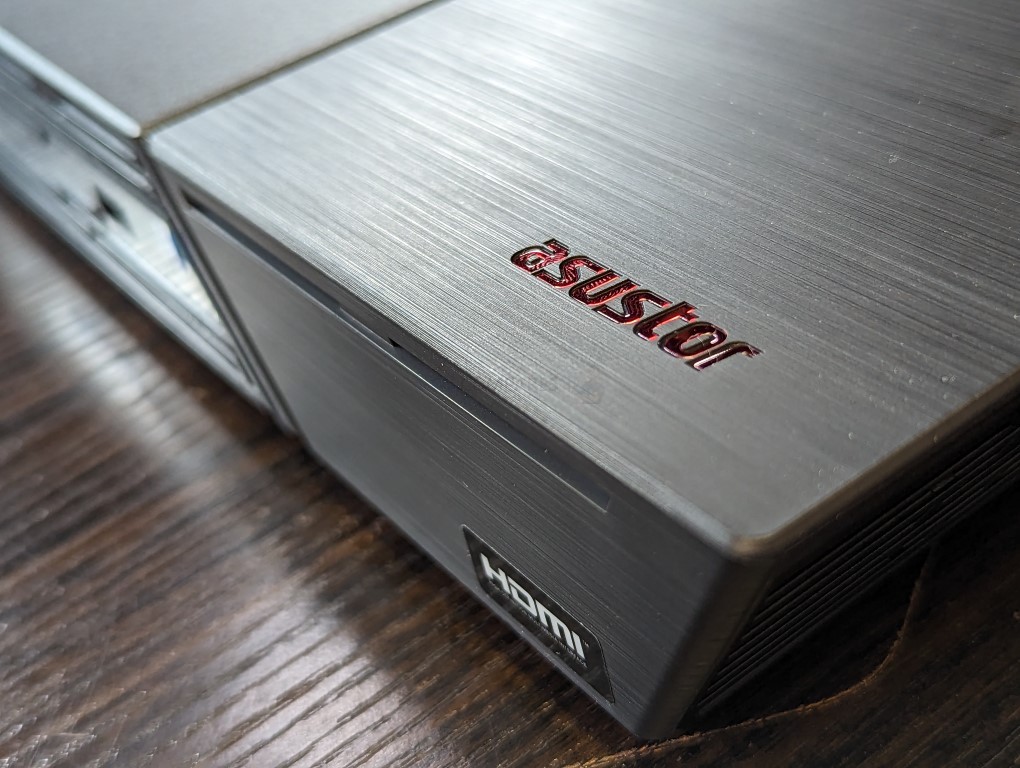
The limited number of PCIe lanes provided by the Intel Celeron N5105 processor may restrict the performance of high-speed NVMe drives. The single 10GbE LAN port also presents a potential network bottleneck, limiting the device’s overall network performance. Users seeking maximum performance and network throughput may find alternative solutions better suited to their needs. Despite these limitations, the FS6712X shines as a storage solution for users who prioritize high-capacity storage, quiet operation, and low power consumption. The device’s ability to directly output 4K video, along with its range of Asustor-approved apps, makes it an excellent choice for media distribution and presentation. In terms of pricing, the FS6712X comes with a price tag of $850+. While this may appear high at first glance, it is comparable to 8 bay drive NAS SATA devices and many of those do not even include NVMe slots or 10GbE. Users looking for a more cost-effective option can consider the Flashstor 6, which offers half the number of slots and 2x 2.5GbE enabled ports for $499. As the cost of flash modules continues to drop, and larger capacity drives become available all the way up to 8TB (even without QLC), the FS6712X provides an attractive solution for those seeking high-capacity and high-performance NAS storage. While some underlying performance relativity by the end user needs to be factored in and hardware limitations exist thanks to the use of that Celeron to remain budget-friendly, the FS6712X is a tremendously smart move by Asustor. A well-designed NAS that presents a much more confident solution demonstrating the benefits of NVMe-focused NAS devices to an audience that would have assumed such things are way, WAY outside the realms of affordability!
| PROs of the Asustor Flashstor 12 Pro FS6712X NAS | CONs of the Asustor Flashstor 12 Pro FS6712X NAS |
|
|
| Model |  |
 |
|---|---|---|
 |
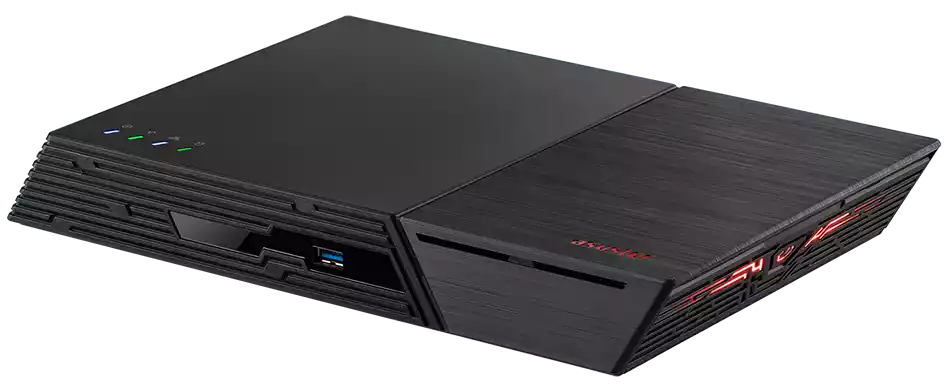 |
|
| Model | FS6706T | FS6712X |
| PRICE | $499 – CHECK Amazon | $860 – CHECK Amazon |
| CPU | Intel Celeron N5105 Quad-Core 2.0GHz (burst up 2.90 GHz) Processor | Intel Celeron N5105 Quad-Core 2.0GHz (burst up 2.90 GHz) Processor |
| HARDWARE ENCRYPTION ENGINE |  |
 |
| HARDWARE ACCELERATION ENGINE | H.264 (AVC),H.265(HEVC), MPEG-4 Part 2, MPEG-2, VC-1 | H.264 (AVC),H.265(HEVC), MPEG-4 Part 2, MPEG-2, VC-1 |
| MEMORY | 4GB SO-DIMM DDR4 (4GB x1, Expandable. Max 16GB) | 4GB SO-DIMM DDR4 (4GB x1, Expandable. Max 16GB) |
| M.2 DRIVE SLOTS | 6 x NVMe/SATA | 12 x NVMe/SATA |
| HDD | N/A | N/A |
| MAXIMUM DRIVE BAYS WITH EXPANSION UNIT | 14 | 20 |
| SUPPORTS SINGLE VOLUME LARGER THAN 16TB |  |
 |
Need More Help Choosing the right NAS?
Choosing the right data storage solution for your needs can be very intimidating and it’s never too late to ask for help. With options ranging from NAS to DAS, Thunderbolt to SAS and connecting everything up so you can access all your lovely data at the touch of a button can be a lot simpler than you think. If you want some tips, guidance or help with everything from compatibility to suitability of a solution for you, why not drop me a message below and I will get back to you as soon as possible with what you should go for, its suitability and the best place to get it. This service is designed without profit in mind and in order to help you with your data storage needs, so I will try to answer your questions as soon as possible.
📧 SUBSCRIBE TO OUR NEWSLETTER 🔔 This description contains links to Amazon. These links will take you to some of the products mentioned in today's content. As an Amazon Associate, I earn from qualifying purchases. Visit the NASCompares Deal Finder to find the best place to buy this device in your region, based on Service, Support and Reputation - Just Search for your NAS Drive in the Box Below
🔒 Join Inner Circle
Get an alert every time something gets added to this specific article!
Need Advice on Data Storage from an Expert?
Finally, for free advice about your setup, just leave a message in the comments below here at NASCompares.com and we will get back to you.
 Need Help?
Where possible (and where appropriate) please provide as much information about your requirements, as then I can arrange the best answer and solution to your needs. Do not worry about your e-mail address being required, it will NOT be used in a mailing list and will NOT be used in any way other than to respond to your enquiry.
Need Help?
Where possible (and where appropriate) please provide as much information about your requirements, as then I can arrange the best answer and solution to your needs. Do not worry about your e-mail address being required, it will NOT be used in a mailing list and will NOT be used in any way other than to respond to your enquiry.
TRY CHAT
Terms and Conditions


Best NAS for under $499
Best NAS for Under $250 (2025)
Minisforum N5 Pro NAS - FIRST IMPRESSIONS
HexOS Q2 Update - What's Changed?
5 Exciting NAS Coming Later in 2025
Beelink ME Mini vs GMKtec G9 vs CWWK P6 NAS Comparison
Access content via Patreon or KO-FI


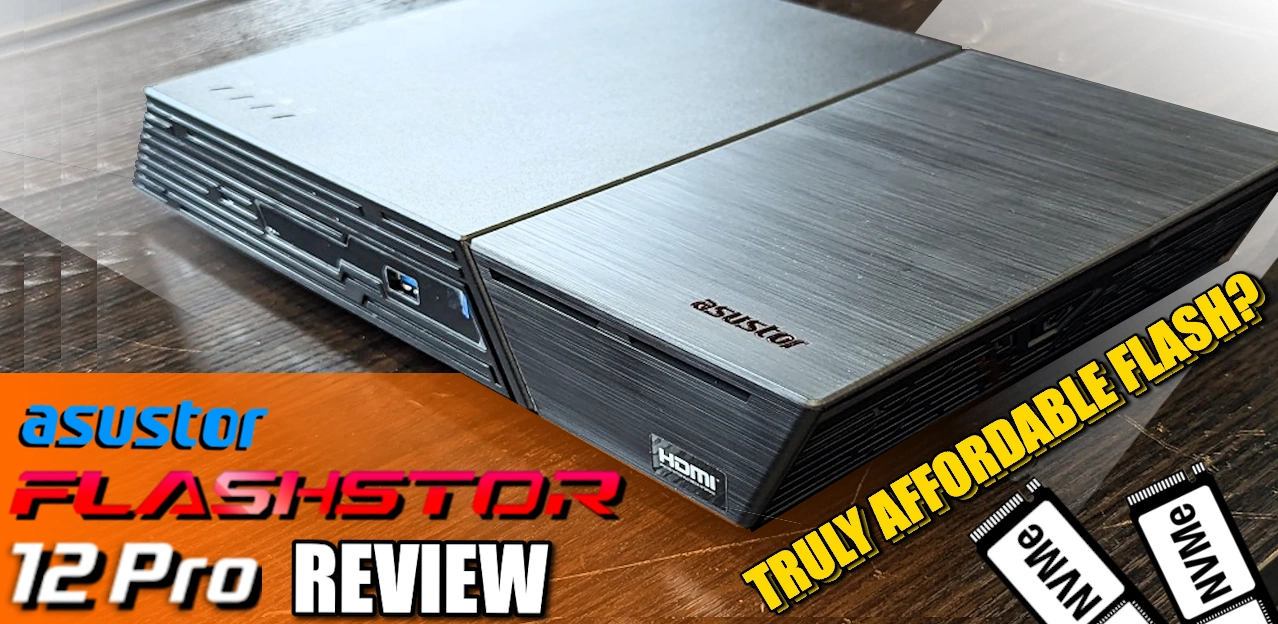
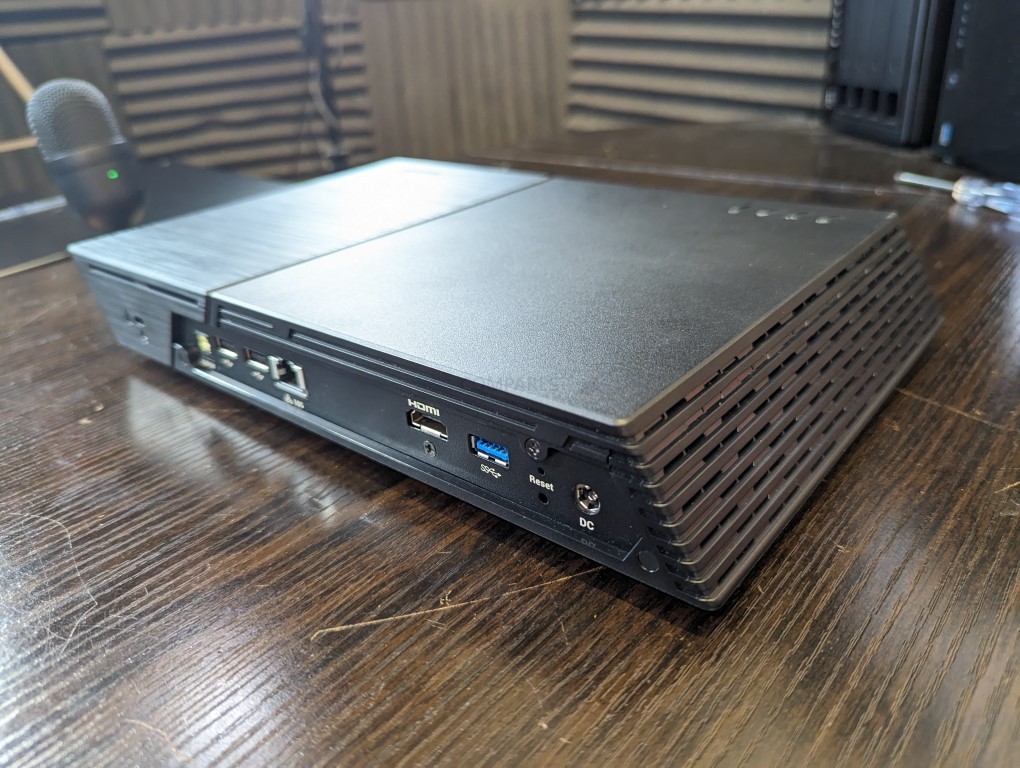
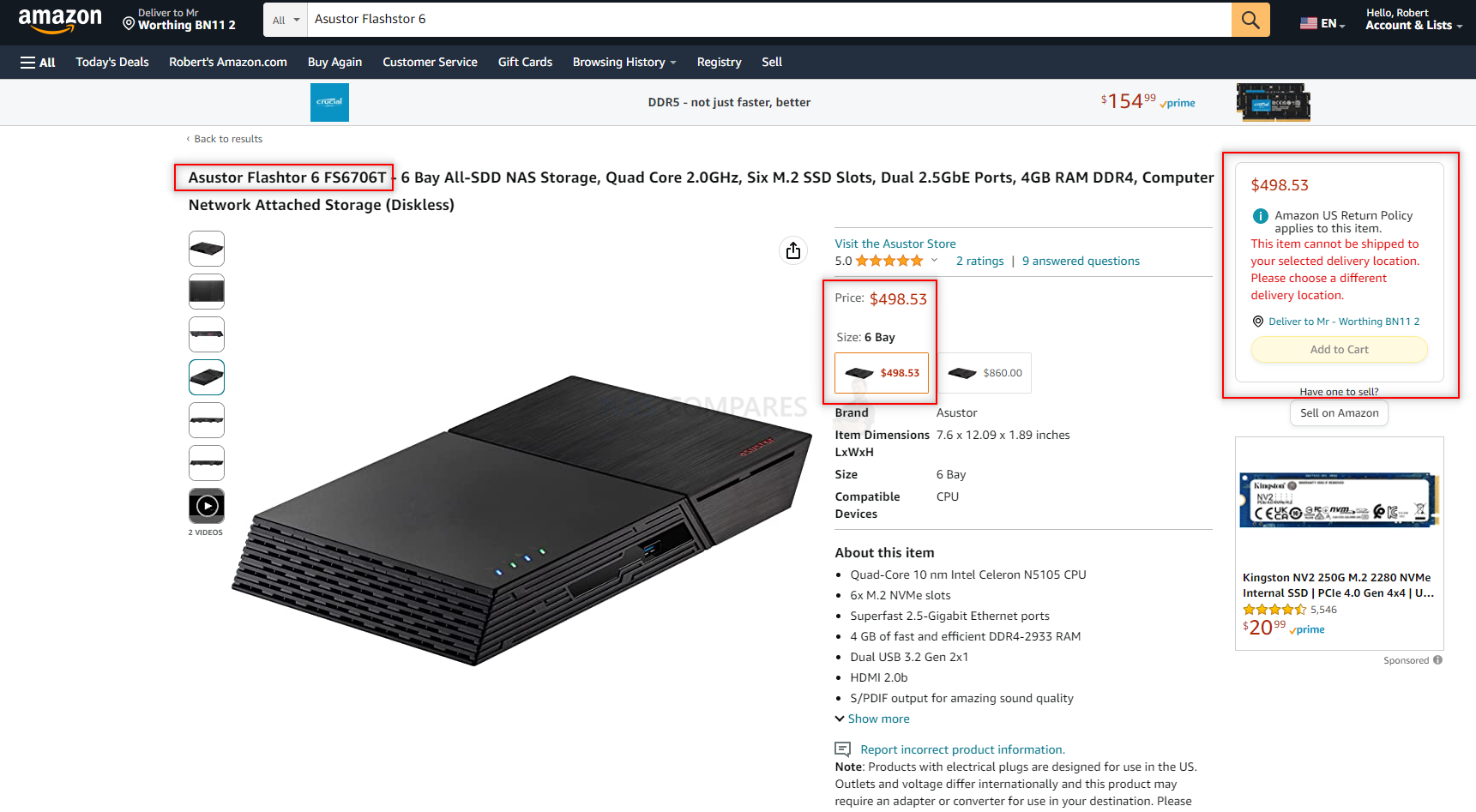

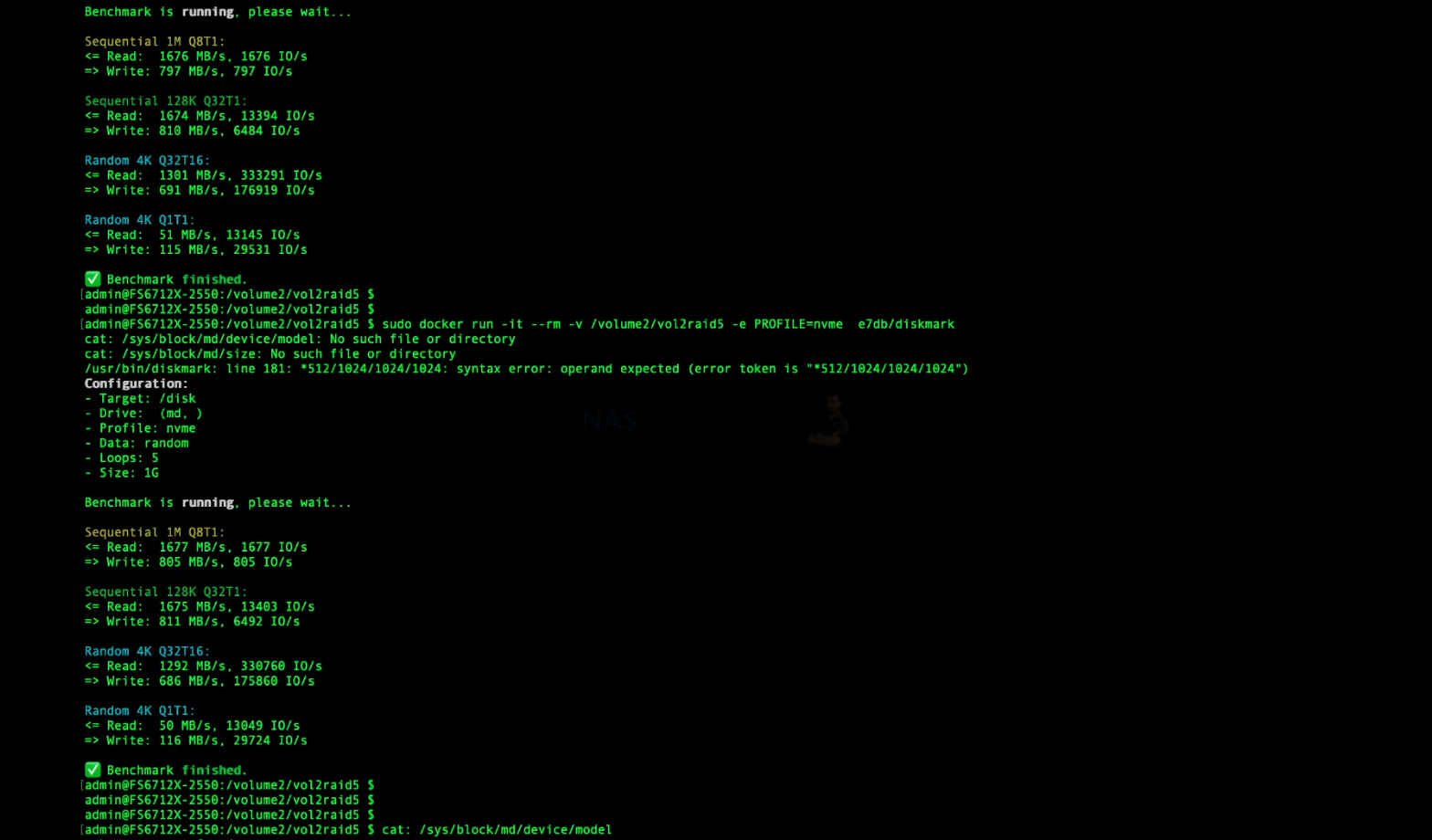
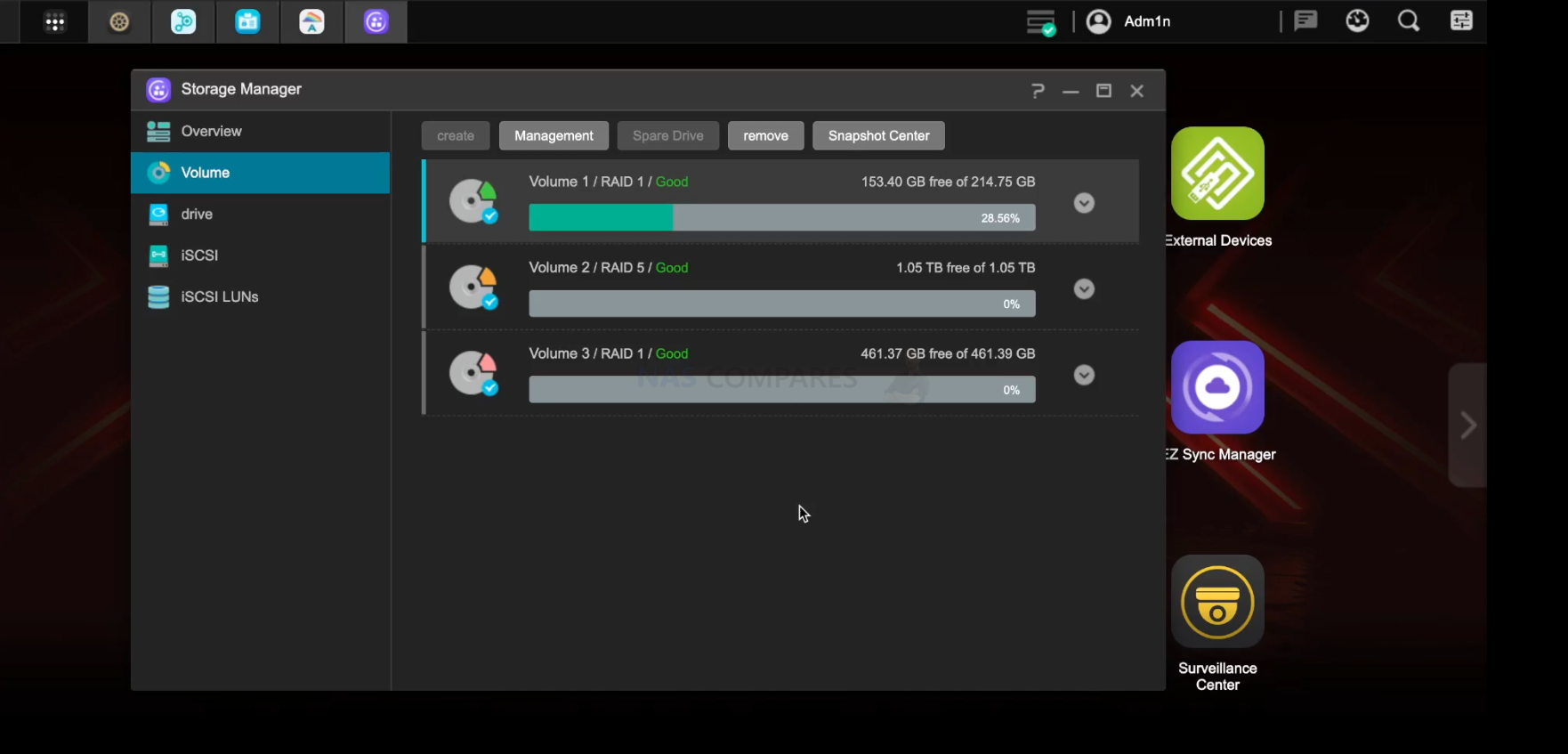
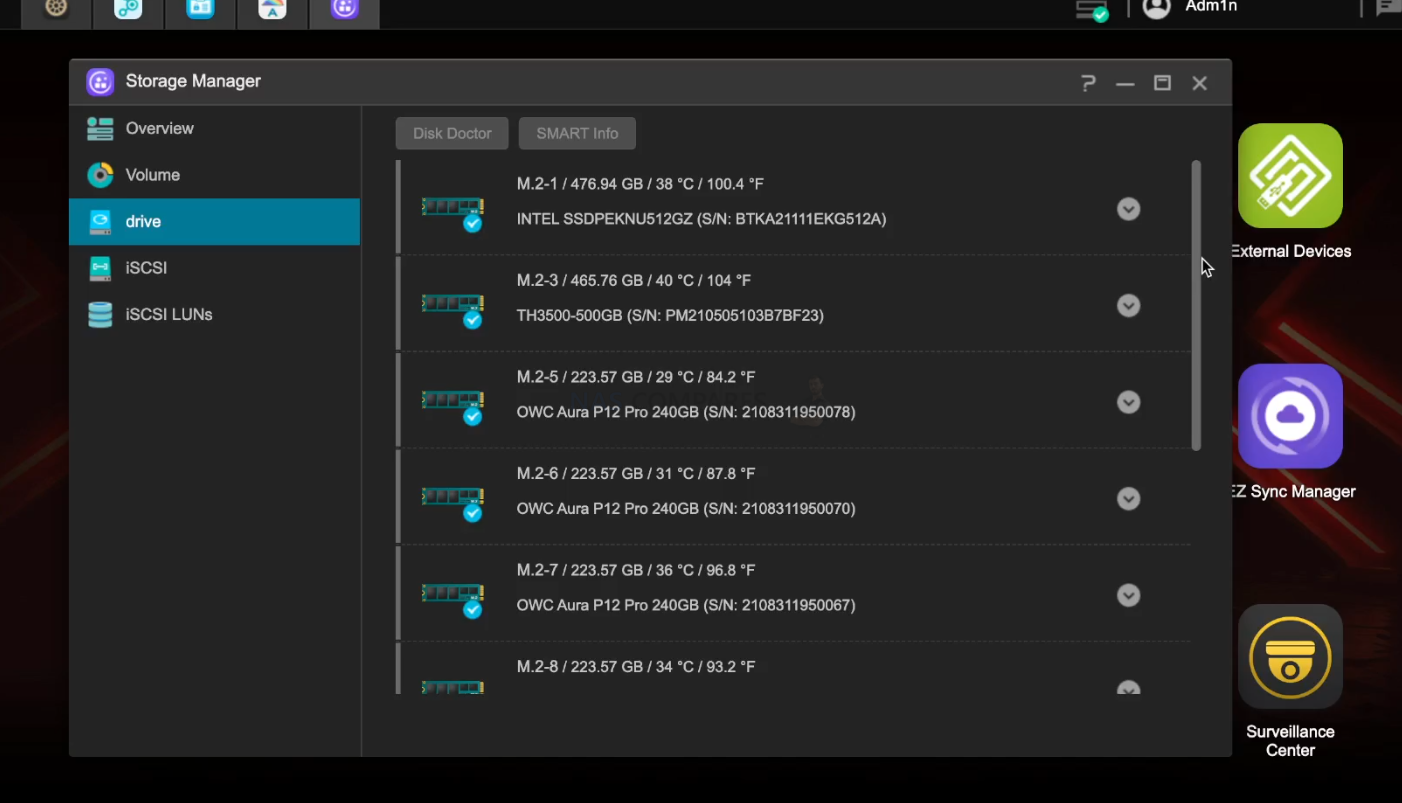
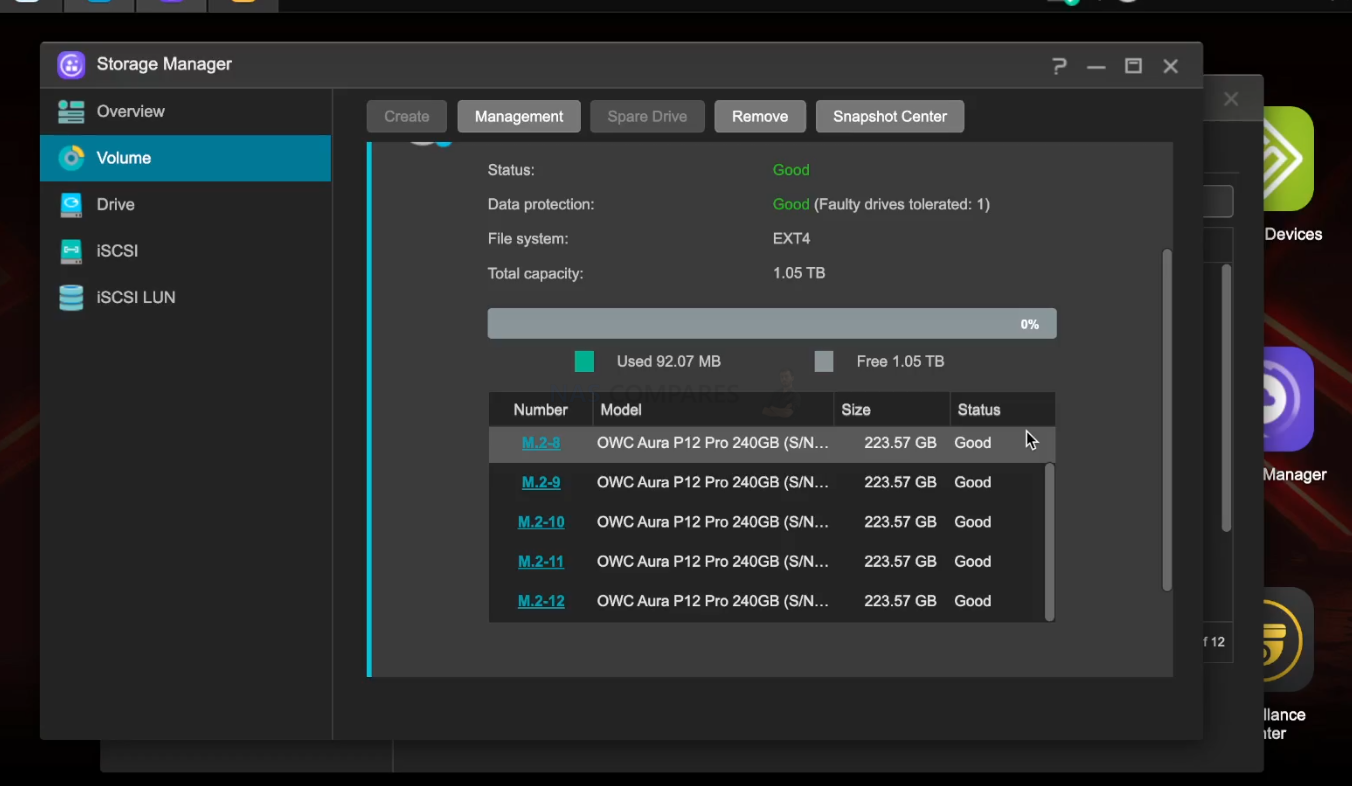
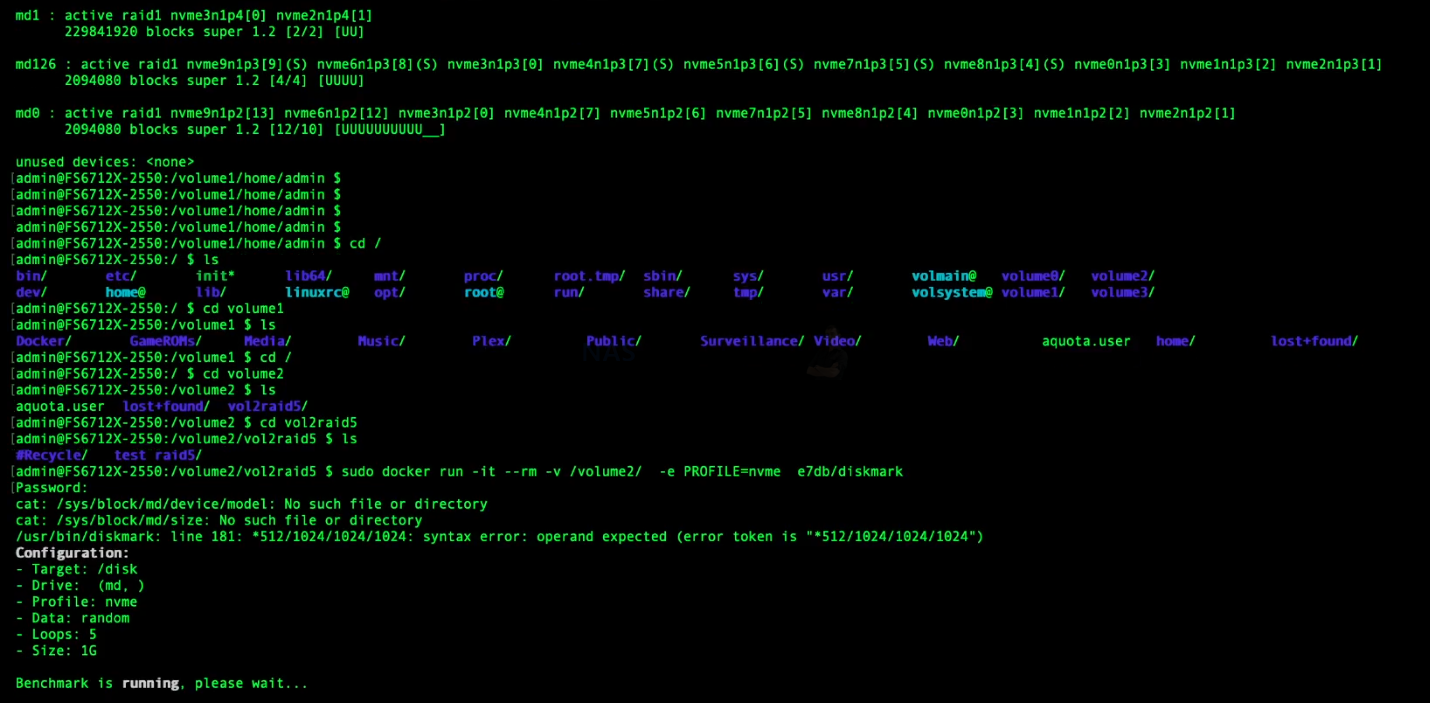




Hello there, I need help. I’m in the process of buying my first NAS for home. My requirements are very simple. I will be using it mainly for storing & viewing family photos & videos (fond memories), movies & music (personal collections) and personal documents. I’m in a dilemma, unable to decide between ASUStor Nimbustor Gen 2 AS5404t (4 bay NAS) and ASUStor Flashtor Gen 1 FS6706t (6 bay all SSD NAS). Kindly help me in deciding – both cost the same in my country right now… Thanks in anticipation.
REPLY ON YOUTUBE
why does it look like a PS4
REPLY ON YOUTUBE
Cool to see a NAS play 4k and 8k, but this seems likely simply solved my running the plex server on your PC and simply using the NAS as a NAS.
REPLY ON YOUTUBE
50:11. There are reports that the heatsink doesn’t touch the CPU area 100%…. So temperature could be lowered I guess
REPLY ON YOUTUBE
And you for being the first and only one I have found that answered my question. “Can you populate this nas as you go? Thank you!
REPLY ON YOUTUBE
When I hear you referring to these units as “cheap” or “affordable”, I have to wonder if it’s me who’s living on another planet, or you. I think they are horrendously priced. Perhaps you are thinking of their use by large companies? But just saying they’re less horrendous than some of their competitors doesn’t make; them affordable for a lot of us.
REPLY ON YOUTUBE
do you speak english?
REPLY ON YOUTUBE
why do you pay for things in knickers?
REPLY ON YOUTUBE
Do you have a video on how to set up fs6706t for a novice?
REPLY ON YOUTUBE
A few 8TB Sabrents in this bad boy would be amazing
REPLY ON YOUTUBE
Hi … i would like to ask you one thing
Am in a confusion. Should i go for synology 422+ or 822+ or asustor fashter 12 drive bcz my main usage is plex media server or just storage and access files from internet when i am outside and save pics while am outside .. .. wht you say … which could be a better option AND ONE MORE OPTION IS QNAP 435 XEU ,,, I LIKE RACK MOUNT SYSTEM BCZ MY ALL MEDIA THINGS ARE INSTALLED IN RACK ? Please tell me which could be a better option
REPLY ON YOUTUBE
Probably a great review video, but I have to say that I don’t understand point #1. I could puke looking at this device, and I wouldn’t even want to put it into a closed cabinet. It’s a great device in terms of functionality and price, I’d definitely want to see more of these on the market, but the design really rubs me the wrong way.
REPLY ON YOUTUBE
Do you have any cpu heat issues? I’ve read on Reddit that some said there is design flaw that the contact of the cpu heatsink isn’t contacted correctly to the CPU
REPLY ON YOUTUBE
The M.2 is still moving data at much faster than the Ethernet speed.
REPLY ON YOUTUBE
Most gen4 SSDs are available with heatsinks, so that issue is solved. Quite an appealing device, this, and the HCL lists a lot of consumer SSDs.
REPLY ON YOUTUBE
Thanks, great detail in the video, especially around capabilities to mix’n’match storage into separate RAID groups. Any chance you’ve done performance benchmarks using RAID10? I’m a fan of RAID10 despite the storage capacity hit, due to the low impact on CPU and typically higher throughputs.
REPLY ON YOUTUBE
Thanks, your benchmark result of <800 MB/s sequential write (Overall) is not far from what I am getting. This is a real world performance. Too bad it cannot hit 1GB/s constant write speed. For others who are interested, initial sequential write speed is close to 1GB/s for first 5sec, after that 850MB/s until 30sec, then dropped to ~600MB/s until the end. Testing using 100GB file. One more unofficial fact is this N5105 works with 32GB Ram although intel specify 16GB as max, and Asustor also put 16 max. I do not have 64GB ram to test. The 32GB Ram i have is stripped from my old laptop, ECC 3200 Mhz Ram (also works as non ECC). Adding ram from 16 to 32 does not help in write speed.
REPLY ON YOUTUBE
I am debating between DIY vs Terramaster F4-423 (currently at $399) vs this unit (Flashtor 6). I’ll be using it for basic storage and remote cloud access (Gdrive GPhotos replacement potentially Home Plex Server). What do you recommend?
REPLY ON YOUTUBE
Seriously considering one of these. M.2 is cheaper than SATA for flash storage.
Any other storage appliance offering a good option for flash storage is incredibly expensive.
REPLY ON YOUTUBE
Good video, I’m thinking about getting the 6 slot version for my storage needs at the lab!
REPLY ON YOUTUBE
Too much talking, not enough substance just couldn’t spend any more time on this
REPLY ON YOUTUBE
Now if I only had $12,000 more to stuff it full of 12 ea 8 TB NVME drives! 🙂
REPLY ON YOUTUBE
This is the third time I see you on YouTube, I just subscribed. This review convinced me to keep watching your Chanel and follow your next reviews. Really good video and great review. Thank you so much.
REPLY ON YOUTUBE
I think the worst Problem is realy the CPU. If Asus has used something like an AMD V1500B or an R2314 with 15 Watts but 16 PCIE 3.0 lanes, they could use 4 lanes for the NIC’s and USB which would be enough to even saturate a dual 10gbit NIC and 2 10gbit USB 3.2 Ports at the same time. That the NVME only run at 1GB/s or 2GB/s at the Store 6 wouldn’t be the problem. But with intel there are no efficient 16 lanes processors, so you have to go AMD which is notorious problematic at providing embedded Prozessors, Synology has some around.
REPLY ON YOUTUBE
After watching your reviews we have bought the Flashstor 12 for our video editing NAS. Great so far. One of our editing laptops is older and only can support 2.5Gb ethernet adapter speeds due to USB 3.1 Gen 1 bottleneck. If I got a second 2.5Gb adapter is it possible to set it up to get 2x 2.5Gb throughput❓ If so what do I need and how do I set it up❓
REPLY ON YOUTUBE
I don’t mean to spam. I put this in an older video for the same.
Thank you for the review of this product.
I have been giving consideration to it and the form factor along with the SSD’s does have an appeal. This would be a home use application that does have SD, HD and 4k movies. There is also a fairly large amount of music files as MP3 and video as well. Other than that, it’s all about data and the combined volume is in and around 7TB. Again; home use two users.
The question: what Drives of good quality would you recommend? I also understand through reading, the device is RAID capable. Is that part correct?
In advance, thank you!
REPLY ON YOUTUBE
Thank you for the review of this product.
I have been giving consideration to it and the form factor along with the SSD’s does have an appeal. This would be a home use application that does have SD, HD and 4k movies. There is also a fairly large amount of music files as MP3 and video as well. Other than that, it’s all about data and the combined volume is in and around 7TB. Again; home use two users.
The question: what Drives of good quality would you recommend? I also understand through reading, the device is RAID capable. Is that part correct?
In advance, thank you!
REPLY ON YOUTUBE
Thank you for the very interesting vid! Should you start using , say, six nvme modules to build a RAID 5 system adding at a later stage 2-4 nvme modules would you be able to expand total size of existing RAID without rebuilding it from scratch ?
REPLY ON YOUTUBE
God I love your videos. I’m looking at a new NAS and this popped up on my search and my first thought was “I wonder if that NASCompares dude has a video about it?”
Of course at a touch over an hour long, you did not disappoint!
REPLY ON YOUTUBE
It’s a shame asussor put such a low powered cpu motherboard combo in there ,I would have loved to see a zyzen aib or it’s version also they really missed a trick by not allowing it to be used as a fast access cashe for its larger gen 2 or small business models
REPLY ON YOUTUBE
The product shows registered, but the website says it’s not, so I can’t open a ticket. I leave voice messages with Asustor and they don’t return my calls. I’m kind of stuck and not happy with their support. The 12 bay unit is displaying errors when I scrub and sometimes says the resource is not available. I don’t have these kinds of issues with NAS units from other brands. I’ve never had to contact the manufacturer for the other NAS units I have. Disappointing.
REPLY ON YOUTUBE
Disappointing. Talking very long about the procuct but still nothing about the noise of the device. If you are just saying “they are not loud” – that is not enough, I have heard the exact same comment about NAS as loud as a hairdryer.
REPLY ON YOUTUBE
In your next video, can you please advise the best NVMEs to use based on the throttling of Gen 3 x 1 and how to populate the NAS for best throughput i.e. is 3 NVMEs with Raid 5 the best. Thanks.
REPLY ON YOUTUBE
Next time, please do deep review for Adm Firewall. I guess many people like this!
REPLY ON YOUTUBE
Fantastic video! I’m new to NAS. I want to setup this device with 12 SSDs and make it automatically backup my various PCs on a monthly schedule. Will this unit and its software let me do that? Thanks.
REPLY ON YOUTUBE
N5105 – Max # of PCI Express Lanes = 8 – Each NVME = Capable of 4 lanes. Whats the point of running NVME? May as well use SATA SSD’s.
Now does anyone (at home) have the capability to run 60Gb/s (12x5Gb/s) networking. Nope. But….. Thinking outside the box and allowing for smb multi channel. maybe a third edition 12 bay, a ‘proper’ processor, with 4 10Gb/s SFP+ on the back and we might have some serious sales. There are definitely people out there who have that sort of capability. (like me)
10Gb networking for home is a sensible price currently with mikrotik but 25/40/100 is still going to be real pricey until corporate entities start rolling this stuff to the pre-loved market
REPLY ON YOUTUBE
From the reviews I have seen it seems like a slightly faster cpu would have been perfect to max out a 10g nic but it is pretty cheap
REPLY ON YOUTUBE
On the market for a new NAS and was thinking about future-proofing the setup. I think some limitations on this machine are in effect to serve a specific niche crowd (the traveler who wants to take their NAS with them). Now I understand that this is why they decided to go for M.2 NVMe drives, I realize now they did not select the M.2 for the performance but to keep the case small. Initially, I wanted this device for its power, but the more I think about it I realize that I’m not the intended audience.
If the 12-slot machine had a CPU with more cores and a bit better performance it would have been a no-brainer. It would instantly replace my home lab and store my data. But besides that, failing drives always makes me nervous and in the past when rebuilding an array it happened to me more than once that other drives started to fail while rebuilding. Being throttled by the 8 PCIe while rebuilding an array is something I really do not like… Then again, it has SSDs and not spinning disks, so performance should already be improved compared to what I’m used to.
I really like the choice of a 10Gbit network port and choice for HDMI. M.2 would be awesome if the PCIe lanes were there to support it.
REPLY ON YOUTUBE
Hi, you were to spend around $600 for a NAS, which would you buy?
REPLY ON YOUTUBE
Thank you so much! Do you know if I can set up a custom database service on that device to make it a Davinci Resolve server for collaborative video workflow in DVR?
REPLY ON YOUTUBE
Are you inside the aircon room?
REPLY ON YOUTUBE
Look like this storage running with Android OS, because i found that the apps are using apk
REPLY ON YOUTUBE
LOL – it’s not affordable at all, but I’d love to own one! 🙂
REPLY ON YOUTUBE
Did you guys do a performance review with multiple clients accessing the plex server?
REPLY ON YOUTUBE
How do I get to this web-based GUI? I can only access wirh ACC or AiMaster. Is there a feature I need to turn on?
REPLY ON YOUTUBE
thanks for your review. I’m about to go for the 12-bay one but I have doubts. It is only for Max studio in 10gb network. could you configure 2x2tb raid 1 (Time Machine) 4×2 raid 5 for Final Cut? and 2×2 raid 1 for Max applications and the nas itself? Could you do it little by little? first system apps then finalcut…. etc (for not having to spend all of one. Would you be able to do that and manage the different raids? Obviously you would look at the ram you have and expand it. Do you know what the Maximum is? I understand it will be ddr4 or dimm 2666? Thanks for your attention
REPLY ON YOUTUBE
Hello. Great review! Is it clear to the user which SSD slots share a PCI lane? I’m thinking dividing the 12 slots into 3 RAID arrays would maximize write performance.
REPLY ON YOUTUBE
at this point, M.2 are slowly getting cheaper than SATA SSDs, but still with bandwidth limitations, something like four QVOs can do equally well in budget Synology device, with SMB Multichannel enabled speeds would be similar, no?
REPLY ON YOUTUBE
For anyone interested, I have six Crucial P3 Plus 4TB CT4000P3PSSD8 PCIe 3.0 and they work just fine in my Flashstor 12.
REPLY ON YOUTUBE
truly affordable £789 ; yeah real cheap £200 max is it’s worth unpopulated
REPLY ON YOUTUBE
I need help
REPLY ON YOUTUBE
I’m having trouble connecting it to SABRENT 10 bay hard drive docking
REPLY ON YOUTUBE
I’m having trouble connecting it to SABRENT 10 bay hard drive docking
REPLY ON YOUTUBE
love the video. i have a some what related Question, can it support the SABRENT M.2 NVMe SSD 8TB Gen 4?? forget speed i am looking to build a DAS out of Nvme ssd’s so here is the question in detail (if i buy this device and put in it 12 SABRENT M.2 NVMe SSD 8TB Gen 4 for a total of 96TB storage and never connect the eathernet cable to it, just connect it to my pc via usb connection and set up the raid system for it, will it work????? ) i keep looking for a NVME ssd enclousere that takes that many ssds but most are big bulky and take like 4) . so can it work ?????
REPLY ON YOUTUBE
Dude, one hour!!! Respect. Can we get iSCSI performance review with ESXi server over 10GB.
REPLY ON YOUTUBE
to slow
REPLY ON YOUTUBE
Would this work for 2 or 3 Apple Final Cut users editing footage gathered on iPhones?
Would the storage via ethernet feel almost equal to that on a MacBook?
REPLY ON YOUTUBE
Any word on when you’ll have the dedicated Asustor Flashstor 12 Pro FS6712X NAS performance review/video published? Really keen to see what it can/can’t do before I buy one.
We have few videos here https://www.youtube.com/@nascompares/search?query=FS6712X
This might be a silly question but if I wanted to use this as an NVR for 3 POE cameras would this be a good choice? Or should I look to go the Synology route? Thanks in advance!
REPLY ON YOUTUBE
Should we worry about most cheap nvme drives do not support trim on raid 5/6?
REPLY ON YOUTUBE
Should we worry about most cheap nvme drives do not support trim on raid 5/6?
REPLY ON YOUTUBE
Should we worry about most cheap nvme drives do not support trim on raid 5/6?
REPLY ON YOUTUBE
Should we worry about most cheap nvme drives do not support trim on raid 5/6?
REPLY ON YOUTUBE
Definitely interested but it is quite ‘plasticky’. I would have been keener to buy with a metal chasis, plastic just doesn’t say quality. I am quite keen to see what the competition produces that is similar. Kudos though for kicking off this type of NAS.
REPLY ON YOUTUBE
Hmm. Need something like this but with ZFS and encryption capabilities. I guess that would need a stronger CPU. I don’t really care about the external bottleneck, even 1 Gb is more than enough for what I need. I do care about the dimensions, noise, and power consumption, which far outweigh the network limits.
Can you boot a TrueNAS on this or is the system drive vendor-locked?
REPLY ON YOUTUBE
I have WD My cloud and no month fee,what are with Asustor?I hear,that for any need to pay any month fee.
REPLY ON YOUTUBE
Silly question but does this (and NAS drives in general) require to be hooked up to the internet to work, or can it be used like a standard external hard drive and simply plugged into a USB port to be accessed by the respective computer?
REPLY ON YOUTUBE
I’ve recently found your site and your reviews here. Great job!
I’d like to know if this would support having a SSD pool to have a PS 5 access it for game storage. Not sure how a PS5 would deal with NAS storage for game content.Any thoughts?
REPLY ON YOUTUBE
Do you answer questions from viewers? I was wondering how it ran virtual machines.
REPLY ON YOUTUBE
The problem would be transcoding. I don’t think any NAS could transcode 4K or 8K very well. Any NAS should be able to serve 4K and 8K files to an external transcoding server or direct to client.
I run a file server on a 4bay NAS (HDD) to an external Plex Server, transcoding on an Intel A380 gpu. I could use any discrete gpu to do the transcoding.
REPLY ON YOUTUBE
It’s not possible to get 10 000 Megs? What unit are you referring to? Why aren’t you mentionning TB instead of MB or at least GB? are you talking about capacity or speed? IF you’re talking about speed why aren’t you saying capacity per unit of time? Like MB per second?
REPLY ON YOUTUBE
12 4TB drives 16RAM MTS900 RAID 0 800MBS sustained 68% processor RAID 5 450-550MBS sustained 81% processor. Spinning drive NAS can easily handle large 1-1.2GBs writes. Reads on the USB ports of NTFS NVMe drive are unbelieveably slow (using the file program on the device). When deleting a volume and recreating one after it’s done the web interface becomes fuzzy and unreadable so you have to log out and back in. So the file transfer performance is a little off. Would I buy one again? Probably. It’s a very good value for what it offers. It’s uber portable. It’s tiny. Very low power consumption. It’s only 50W but it’s the warmest 50W I’ve ever felt. It will probably put Asustor on the map. You’re not going to want to put a spinning drive NAS that can handle what this does in your carry on.
REPLY ON YOUTUBE
????????????
REPLY ON YOUTUBE
This is insane. To think, most people haven’t even adopted 4k while still in the 1080p world. I don’t even know if 8k monitors exist? We’re starting to see petabyte storage systems if this format adopts. Thanx Rob – great episode!????????????
REPLY ON YOUTUBE
Are there any tools you are aware of to sync files between this and Synology?
REPLY ON YOUTUBE
I do not understand when you state the Plex client is struggling. It appears to be working properly.
REPLY ON YOUTUBE
tbh there is no need for 8k @ home unless you have like a 100+ inch tv
REPLY ON YOUTUBE
Why aren’t you showing the transcoding details in the Plex dashboard?
REPLY ON YOUTUBE
5:30 4320p is 8K
REPLY ON YOUTUBE
14:04 — “a thousand megs per slot” . . . but assuming that is (or is not) with all six slot filled?
For instance, if I make a pool out of three of six slots on FS6706T, then will each slot in such a pool get double that (i.e., 2,000 megs per slot)?
With much appreciation. Great video ????
Kindest regards, friends and neighbours.
REPLY ON YOUTUBE
Is there any drawback to connecting the NAS to a Mac Studio with SSD for the 10G speed and the rest of the computers on the network via ethernet? Do you get the same functionality in terms of storage and apps?
REPLY ON YOUTUBE
First impressions: it looks like a sideways view of a Courier HST (well, you are taking a trip down memory lane).
REPLY ON YOUTUBE
Do you think m.2 with heat sinks would fit in there?
REPLY ON YOUTUBE
I have a 4 bay lockster now. Use for file sharing in a home office with four users. Had it in service for 5 years. Has 2 4tb hard drives not even close to full. Wanting to upgrade and use the older model for a backup device. I would like 10gb access. Which is better solution flashstor or locker. Locker is advertised more for gaming and plex. Not sure of the advatages it would serve for file sharing. Hdd per gig still cheaper on standard hdd.
REPLY ON YOUTUBE
I have a 4 bay lockster now. Use for file sharing in a home office with four users. Had it in service for 5 years. Has 2 4tb hard drives not even close to full. Wanting to upgrade and use the older model for a backup device. I would like 10gb access. Which is better solution flashstor or locker. Locker is advertised more for gaming and plex. Not sure of the advatages it would serve for file sharing. Hdd per gig still cheaper on standard hdd.
REPLY ON YOUTUBE
Is not need ECC RAM for a reliable NAS?
REPLY ON YOUTUBE
Is not need ECC RAM for a reliable NAS?
REPLY ON YOUTUBE
Go and see a dentist to get your teeth fixed.
REPLY ON YOUTUBE
You’ll need to include a “knicker to currency” exchange rate in your videos.
REPLY ON YOUTUBE
Only if it was in an aluminum case, removable network adapter, more memory and have my cpu power. Everything less is awesome.
REPLY ON YOUTUBE
To me it all starts and ends with the CPU, they messed that so much that I’m gonna skip this and not even blink
REPLY ON YOUTUBE
Is it possible to implement RDMA or SMB Direct or RoCeV2 with an all flash NAS? Even other brands? Windows has supported RDMA for almost a decade now, but it seems QNAP, Synology, Asustor, etc do not support any RDMA protocols that will actually enable speeds up to 100 Gb/s with 100 Gb NICs. Im running into a brutal 55 Gb/s bottleneck and it seems to be that the NAS does not support any of these RDMA options. Are there any NAS systems that ACTUALLY, really, truly do support AND are capable of 100 Gb/s?
REPLY ON YOUTUBE
Out of stock or 1-2 month wait. Looks like a fun device. I’ll take another look when it’s more widely available.
REPLY ON YOUTUBE
On first glance, the first use case for one of these that I can think of is for off grid use – cottage, boat, motor-home / trailer (caravan). The NVMe storage is just too expensive vs HDD’s for uses that many of us would have especially if that is media heavy. But, from what i can find online, the power consumption of NVME’s is only about 25% of HDD’s. And that means less consumption of battery power.
REPLY ON YOUTUBE
Thank you, boss, for your effort, do you think Flashstor 12 Pro is good enough to install the proxmox backup server with 10Gb linked to switch 10Gb too, I will use it for delay backup in my full rack in my colocation in London?
REPLY ON YOUTUBE
I saw your review of the Asustor Flashstor 12 Pro NVMe NAS and liked it, but I think there is missing information, such as:
The type of memory used, is it ECC?
Do we need to buy heat sinks for the M.2 drives?
What is the type of the PCI lane connection, is it 3.1 or higher?
Best budget that i found in Portugal was:
Nome Marca unidade Preço Totais Preço Final
ASUSTOR 12-Bay M.2 FLASHSTOR 12 PRO Asus 1 898,90 € 898,90 €
Samsung 2TB SSD 970 EVO PLUS M2 PCIe – MZ-V7S2T0BW Samsung 12 113,58 € 1 362,96 € 2 333,90 €
Samsung 2TB 980 Pro NVMe – MZ-V8P2T0BW Samsung 12 143,82 € 1 725,84 € 2 696,78 €
Memória RAM Kingston 16GB 2666MHz DDR4 Non-ECC CL19 SODIMM – KVR26S19S8/16 Kingston 2 36,02 € 72,04 €
Just for reference. Thank you for your attention. Keep up the good work.
Best regards.
REPLY ON YOUTUBE
I just received and setup my 6 drive version. I installed 4x 4TB Crucial RAID5. I’ll get 2 more soon I suspect but am hoping 8TB NVMe’s will get cheaper. I have to say the experience was superb! Very straight forward. I’ve had a Synology DS918 for the last 5 years and both are good, but I find the Asustor a bit easier to use.
The Asustor Folder app was amazing for making easy to copy content from my backup ext 16TB drive. Simply drag the files from the USB attached ext drive to the folder I want, and done.
I’ve got 1 of teh 2.5GBit ethernets in use and get ~270-280MB/s transfer from my PC too! Very nice! So much better than the 112MB/s on my Synology.
REPLY ON YOUTUBE
Nobody says “Nicker” nowadays… but thanks for the flashback ????????
REPLY ON YOUTUBE
hello sir. do you have/can you make a video about recovering data files from nas drives? my ts-451 failed but the drives are qood. sadly they are not ntfs so windows cannot read them. thank you.
REPLY ON YOUTUBE
So it probably would be great as a media server, albeit with “dumbed down” / early generation SSDs?
REPLY ON YOUTUBE
Why do you always pronounce Ryzen “Ryzon”?
REPLY ON YOUTUBE
Hi NASCompare, thank you for all of your video, it does help me a lot in choosing NAS that I want. Can I check with you whether DS223+ support active business backup? Thank you.
REPLY ON YOUTUBE
DIY version 4bay Nvme+2 2.5ssd : Inwin Chopin or B2 itx , amd itx board with dual nvme , 5600G or 5300G , pcie split enabled and slap on a 8/4/4 pcie riser .
Now you got 4nvme with 4lanes to each drive plus two 2.5 drive bay
You still got a free x8 pcie slot
REPLY ON YOUTUBE
What are the chances of getting a video loading truenas on this?
REPLY ON YOUTUBE
But, it just looks so, ugly!
REPLY ON YOUTUBE
Damn, I thought you were going to say the NAS is unbelievably also 250 knicker!! Tut, now it’s expensive!
REPLY ON YOUTUBE
No UK stock anywhere ????
REPLY ON YOUTUBE
Is using NVMe SSDs a good idea? I have heard that after awhile with constant READ/WRITE SSDs wear out. Heck my computer recommends NOT defragging the SSD. With that said, I have had my Surface Book 2 since 2018 with no issues. I am shopping for a solid inexpensive NAS and this one looks interesting. I do video and photo editing and I need a NAS with decent performance and large capacity.
REPLY ON YOUTUBE
I think we know what’s missing here… based on Asustor product naming convention, IMAGINE that : Asustor Flashtor 6 Pro FS6706X (yes 6-bay 10G) for $599 🙂
REPLY ON YOUTUBE
I have a synology ds1821+ which is loaded with 16tb drives which I use only for video editing + huge amounts of video file storage and pictures and have 10gb switch and It works well but is noisy when the drives spin up. Would using this Asustor NAS filled with 4tb or 8tb drives be better speed wise and without the noise, heat and power use when it’s left on 24/7?
REPLY ON YOUTUBE
Will qlc be good for esxi nfs share of datastore or it that going to be to many writes ?
REPLY ON YOUTUBE
First of all thank you for your clear and complete review.
What I do not understand with this NAS is the intended market:
With 12 drive slots, the prosumer seems to be addressed.
However, a prosumer wants hot swappable drives and absolutely no power down to add or replace a drive. Unscrewing the case to get to the drives is also not on the wish list.
Is it something for the home user? Want those 12 drive bays?
All in all, I don’t see a market for a product like this. But I could be wrong. The sales figures will tell the truth.
But thanks again because it is precisely through these kinds of clarifying reviews that customers can make the right choice.
REPLY ON YOUTUBE
How is Photo Gallery 3 + AiFoto 3 experience with it?
REPLY ON YOUTUBE
1. The product page on the Asustor website indicates that the DSD audio is supported via the Hi-Res Player app. But according to the Asustor Compatibility – USB DAC webpage, none of the supported DACs support DSD.
2. Per the Asustor M.2 SSD Compatibility list, the only 4TB drive supported is the Gen3 WD Red WDS400T1R0C-68BDK0. There are plenty of other worthwhile 4TB Gen4 drives available at the same cost. Those aren’t supported by the FS6712X.
REPLY ON YOUTUBE
I hope Synology will also bring an affordable version of the Flashstation
REPLY ON YOUTUBE
29:27 Nooooooo We got Synullified! Flashstation Oh geez.
REPLY ON YOUTUBE
14:14 The seagulls are trying to tell you that we don’t have enough PCI Express for another Gigabit port, but we have the USB port for our 2.5-Gigabit adapter if you wanna do that.
REPLY ON YOUTUBE
As far as I’m concerned, even neglecting the (not indifferent) problems related to CPU performance and PCIe lanes, Asustor currently certifies only one 4TB M.2 HDD model, the WD Red SN700, which where I live comes to cost 379€ which multiplied by 12 makes the silliness of 4.548€… to have almost 41TB of available space in RAID 5.
If I bought a 6 bay NAS with 6 20TB disks (ex. Exos X20) I would pay around €1.824 which in RAID 5 translates into around 93TB of available space.
41TB for 4.548€ (110€ / TB) Vs 93TB for 1.824€ (19€ / TB)
For my needs (my CD / DVD / BRD / BRD-UHD ripped available on Plex / minimserver at 1:1 quality, my photos and a few family videos shot on a MiniDV years ago), I’d say there’s nowhere near competition. ..
The fact that the NAS costs little is irrelevant.
BTW: nice video, as usual ????
REPLY ON YOUTUBE
Hello! We’re back to watch the featured presentation of Robbie rambling on about this NAS for an hour. We can’t complain if we’re getting what is quite honestly the longest video on the channel. We love his ramblings. But we’re here and busting out the popcorn to watch a video that is way better than any movie I can see at the cinema. And while we do that, we’re just happy to answer your comments, questions, praise, and criticism! Sit back and bootstrap on. It’s a doozy!
REPLY ON YOUTUBE
Due to the throttling of the SSD’s, what 4TB sticks would you recommend?
REPLY ON YOUTUBE
Please, please stop using the astonished “Mr. Beast” look thumbnail for the upload.. It is an instant turnoff.. ????
REPLY ON YOUTUBE
I really miss the youtube app in NAS (AS6704T) to watch it on my TV. Asusstore please add it app central.
REPLY ON YOUTUBE
Spdif is a no for me. I am getting one of these but will be going Ethernet to my transport to the DAC. This will be replacing my DS220+. Fits and better looking ????
REPLY ON YOUTUBE
Let’s all face facts – if you’re expecting to fill a 10Gbps link with traffic all the time, or want/need a 25Gbps or 40Gbps+ link, you’re not looking at Asustor. You’re looking at professional solutions. My potential use for this is in long-term NAS storage, not performant storage. Meaning, I want to have 12x4TB disks in RAID 6, and load them with Plex data, and let them sit there. For over a decade. And be reliable. Something spinners can’t really nod their head at. With RAID 6 NVME drives, I would expect easily 10+ years of use – I’d expect that the CPU or memory may suffer a defect long before the drives die. The only thing I wish the 12 bay unit had would be dual 10Gbps ports – not for throughput (and I’m sure some people would scream about that) but for redundancy, so that if I do a switch upgrade and it reloads, nothing is interrupted from a file mount perspective.
REPLY ON YOUTUBE
Good NAS Good job ASUSTOR
REPLY ON YOUTUBE
*Note* – Fairplay to @ASUSTORTV , after my criticism of the system not arriving with M.2 SSD Heatsinks, they have produced a test video showing compelling evidence that the PCIe Gen 3×1 slots are not able to generate enough heat on a x1 speed each. I will be conducting sustained tests later on that factor in spiked use, but I have to hand it to them, it is a great response and makes a solid case. You can find their video here – https://www.youtube.com/watch?v=Vr__5B3oGtM
REPLY ON YOUTUBE
Some notes about these Asustor FS 67 series NVMe NAS’s….
1. Currently the only 4TB NVMe supported is the WD RED 4TB (WDS400T1R0C-68BDK0) per the Asustor HCL .
2. The NAS will stream DSD (up to quad-DSD) to an attached USB DAC. However, none of the USB DACs listed on Asustor’s HCL support DSD.
REPLY ON YOUTUBE
cand the SSD be mix and match or all the same?
REPLY ON YOUTUBE
So if I understood this right, If I’m still running a 1Gbps switch/router my home network would be the bottleneck not the NAS itself right (with the 6 bay)
REPLY ON YOUTUBE
The 1GBps per drive comment isn’t exactly accurate. Due to the CPU only having 8 PCIe lanes, they’re using ASMedia PCIe MUX chips to share all of the PCIe bandwidth. In a RAID6 array with all 12 bays populated with 2TB Intel 670Ps, I haven’t seen more than around 3100 MB/s reads and 840 MB/s writes.
REPLY ON YOUTUBE
Wait… Let’s nip this in the bud, shall we. Making no apology, this is a ha’p’orth o’ tar situation, though in NAS terms we are talking more leaky coracle than creaky man-o’-war. More than that, here is an offstage exercise in elephant wallpapering. Having said that, I do agree pretty much with mostly all you’ve said in your pros and cons presentation, and with ASUSTOR TV clarifications and rejoinders – but!
It’s one thing to announce that the Flashstor is populated exclusively with NVMe cards, whilst waving the like to your ear. I can’t fault your delivery. It’s priceless. NVMe cards are silent as a dead parrot, of course. But the so called bad boy Flashstor NAS – with a manufacturer stated Operation Noise Level of 18.7 dB due to the built-in active cooling fan – is, well, audible. Not just audible, but with a strangely metallic, nay, ironic quality to the noise it produces.
Very quiet, and barely noticeable, are relative euphemisms, like almost silent, not useful in translation. Every ear hears what it will. An acceptable level of noise depends subjectively on individual use case scenarios. I suspect the majority of any gathered assembly will be quite comfortable agreeing to differ on the intrusiveness, or otherwise, of a quiet device.
Should you buy it? On a promise it never makes and doesn’t need to keep? See below. Even if you convince yourself to overlook the inclusion of a fan in the specification you won’t be spared the morning after. Remove the fan, or if it stops working of its own accord, and there is a series of loud beeps to alert all those within earshot. No secret. It insists functionally on being present and correct, and, as I may have indicated, it is noisy. It oughtn’t be, but it is. Thanks to two significant factors: a) aerodynamics, that is diameter/rotational speed/blade design, and in particular b) dual ball bearings.
I suggest a line be drawn at the apparently casual use of the word silent since it means something entirely different, by varying degree indicative of subjective experience of noise level, to the word quiet. (Aside – You might want to call the latter virtual silence. Mmmm, a bit 70’s. How about artificial silence. Ah, yes, now that’s modern. Of course, it still means categorically not silent in any way whatsoever, rather of questionable value, a compensatory poor substitute for the real thing. Who cares.)
If you require silence, as in Solid State Drive, and wish to eliminate noise, as in Hard Disk Drive, then buying this machine is a straight forward mistake. Silent running is statedly not a design goal of Asustor for the Flashstor. That being the case, what exactly is the unique selling point of it? The case is sturdy, but looks ridiculous and those are fake exhausts on the front, whatever Robbie told you. If the proprietor also spreads the idea that its firmware potentially is written to deny service to those seeking to install other operating systems or scupper rival investment group’s memory modules then at best it is an impressive marketing exercise. Impressive as in pressurised sales loosening your grip on reality and in turn making a big dent in your paltry bitcoin collection. So keep your eye on the pea. Let’s go.
Highly desirable, a silent domestic NAS device is a simple and clear objective concept. A design goal. Not a missed target. Not an Asustor. Not even a Flashstor. Not yet, anyway. To this day, the only silent NAS is a NONAS.
“We really wanted to make this quiet. Otherwise it defeats one of the purposes of an SSD NAS.” ASUSTOR TV on Flashstor thermal design.
There it is again. That word. Quiet. Which means a degree of noisy as opposed to silent, which still means no noise.
My DS415+, admittedly with Noctua fans, is quiet. The reason for upgrading the fans is to eliminate the metallic grinding sound of ball bearings, to make the fans mostly tolerable. But it isn’t silent with four WD Red 3TB HDD. The escaping chronic fixed level mechanical grinding sound, more than the lively seek chatter, is a depressive ergonomic that is unnatural to the ear and a factor in long term hearing loss. That’s why most sysops tend to not live in the server room, or for that matter the plant room, or indeed the belfry. What? Away then, with those naughty hard disks and their moving parts.
“We really wanted to make this quiet.” Really. If by quiet you mean to some extent noisy, you succeeded. You didn’t. You did otherwise. Strange, but true. In doing so, as vouchsafed, you defeated one of the purposes of an SSD NAS. The distinguishing purpose presumably being to follow through silent (not quiet) solid state disks with a silent (not quiet) solid state chassis. You know. Silent storage. Instead of quiet (to some extent noisy) storage.
By design. Quiet and not silent. Why is that? It needn’t be that way. Why stop at swapping out the last of those noisy spinning hard disks to do only half a job by leaving in a noisy spinning fan?
With respect to the Flashstor, use of the word silent is merely adjectival funny business, or perhaps fanny business. What I mean is this. A useful practical description of an object ought to align itself with the uniformly objective convergence of common experience and yield to independent measurement and verification. Thus, silent is probably a non-starter as there is a ball bearing attached. Unless that fan is off, that is, or running on mag-lev oil bearings below the bar of a gentle draught, which it isn’t in this case.
Thursday there were two Flashstor 6 in stock on Amazon UK – then there was one. Closer inspection of the design would suggest that Asustor decided wilfully not to render the wannabe silent NAS in fact, silent. The thick plottens. The design includes certain case screw heads, including the fan screws, buried under pressed and recessed hard plastic caps that defy attempts to disassemble. The dimensions of the custom fan itself are suboptimal to sourcing better performing parts. Fan replacement is therefore a factory repair. Good luck with that. One is physically hampered even from modding the Flashstor for peace and quiet. One may be seen but not heard, but one’s NAS – not so much.
When the Flashtor NAS is up and running, it’s tiddly built-in fan is up and running. The ball bearing noise can be heard distinctly and penetratingly across the room. This is not to mention the rushing sound of air. Asustor has almost succeeded with that, although the fan is rather small. In fact the airflow can only be heard if one waves the entire NAS to one’s ear or, equally, places one’s ear really quite close to it.
That is not the major problem. The fan shifts enough air at idle to keep the inner workings from overheating and the airflow often is inaudible depending on the ambient sound of working conditions. Only in the dead of night, when you should be asleep anyway, or if you are fortunate enough to work in library conditions, can this humble rush of air be heard. The poor wee fan has to work the surrounding air a little too vigorously to waft the necessary draught. The sound level is very much like a DS423+ on SSDs, sporting replacement Noctua fans fitted with series resistors. Don’t ask me how I know. Don’t get me started on those cheap rattly Synology fans in a flimsy case. Why do you think I took in the Flashtor? Desperation. It certainly wasn’t for looks.
I want to live with my NAS, not to have to listen to it when I require to hear a pin drop. A little more commitment to acoustic performance could easily have resulted in a silent Flashstor. Misanthropic marketing motivated by the boundless wonder of public imagination supposes why produce something good and well-engineered straight off the bat when you can sell it again, and again, and again. To the tune of a waltz.
The problem is this. And this is the whole point. Asustor have used, not the cheapest fan design it demonstrates reasonably good aerodynamics and manufacturing but cheap enough to suffer from noisy ball bearings. I say suffer, because the sound is remarkably similar to the grinding sound of a spinning hard disk.
So here’s a paradox for you. The elephant in the room is the Flashtor itself. As a design and marketing concept it is admirable: bold, striking and courageous. However, you could say that its greatest asset is at the same time its inevitable downfall. It is a victim of its own success. It contains the seeds of its own destruction. In other words, it has balls. And it’s a little fanny.
There is only one thing more disheartening than suffering from noisy ball syndrome, and that is foisting your head splitting ailment on sensitive, imaginative types who are trying to manifest (let’s be generous) original thinking. That, and the blinding irony of an SSD NAS sounding for all the world like a wheezy old dog of an HDD chassis. Oooh, the bells! The decibels!
12th Gen Intel NUC with a Core i5-1240P 35W TPD in the Akasa Turing passive case with a 2.5″ SSD, mSata and NVMe is for real. Silent. Oh, the sheer relief. Obviously, that represents overkill for power in a domestic NAS. Count them. How many cores? But proof of concept beyond doubt by an order of magnitude. The removal of barriers to achieving a silent NAS. How are you going to test the market for silent NAS if you don’t release one? I see, you are testing the market for the acceptance of a decoy. As long as that’s understood. You can be the best at taking the pea.
REPLY ON YOUTUBE
The asking prices though, holy F. These name brand NAS companies trying to do Apple pricing based on aesthetics. SMH…
REPLY ON YOUTUBE
can you run Truenas on these instead of the Asustor os?
REPLY ON YOUTUBE
Honestly I would not trust asus drivers.they dont qc firmware updates
REPLY ON YOUTUBE
I don’t trust the chinese Asus one single bit. Their customer service is pure crap. Here’s their latest “screw the customer” fiasco. https://youtu.be/cbGfc-JBxlY
REPLY ON YOUTUBE
Just please someone to tell the manufacturers, to put full size pci slot (or mobile 3070 soldered to the mb) and space for gpu and here you go, the perfect plex server ????????????
REPLY ON YOUTUBE
I bought one of these and decided to go for the Flashstor 6 version.
I simply couldn’t justify the jump in price between the FS6 to FS12 for an extra 6 drive slots and the 10Gb LAN.
For me tge FS6 is plenty fast enough.
The reason I devided on one of these is they are almost silent and use barely any power. In sleep mode they make no noise at all and use literally nothing (less than 1 watt). But the main reason is they wake up from sleep in less than 2 seconds vs my Synology NAS which takes sone 40+ seconds to wake all the drives up and come to life.
Mine is not accessible online and i only access it via VPN so my data remains safe and its plenty fast enough for moving files around my network vs my Synology with its limited 1Gb LAN ports (why Synology).
The only slight issue i have is with regards to the NVMe drives. Because there is limited compatibility listed on the Asustor site for these i thought I’d try just a couple of Samsung Evo 970 Plus 2TB drives to start with and if tgey worked ok I’d add more.
I bought two and set them up as RAID 1 and everything worked fine.
I then thought id add another and change to RAID 5, so i got another 2TB exact same drive bought only 2 days later (all bought from Amazon). It set up as RAID 5 fine and seemed all ok but the 3rd drive seemed to be considerably hotter than the previous two.
Also i noticed the 3rd drive was showing as having “ERROR INFORMATION LOG ENTRIES” when i checked that drive in the NVMe SSD status log.
I assumed that drive might be faulty so RMA’d it. But the replacement was exactly the same. So i completely deleted the volume and set all 3 drives up a fresh as RAID 5. But that 3rd drive is still getting the ERROR INFORMATION LOG ENTRIES which is odd. The initial two drives don’t have them and they are exactly the same drives.
Ive tried swapping drive slots etc but that 3rd drive just seems different. The only physical difference is the first two drives were manufactured date of 2022 but the 3rd (and replacement 4th drive) are manufactured dated 2023 so presumably newer firmware.
Any ideas what these ERROR INFORMATION LOG ENTRIES are and are they a reason for concern? Why does this 2023 drive have them but not the 1st two drives?
@Asustor TV
Apart from that issue im loving the system and its a great price too for such a silent, low powered (energy wise) and rapid system)
REPLY ON YOUTUBE
You should put the video title “You Should Buy”????????
REPLY ON YOUTUBE
What would it take to get the Synology OS Software installed onto 1 of these?
REPLY ON YOUTUBE
What use cases are these useful for? Seems overkill for home use, seeing as you need a network setup beyond most home networks, and is this sort of performance really needed for Plex? If you’re doing home video editing why not store the videos while editing locally and then backup to NAS. Just curious.
REPLY ON YOUTUBE
Are there any other brands beside ASUSTOR that offer NVME NAS storage?
REPLY ON YOUTUBE
I hope you do a followup on this device with a recomended ssd choice and tests. The hdmi output is also interesting. How well would that work vs. Accessing media on the network.
REPLY ON YOUTUBE
A better CPU could have gotten Gen4 NVMe speeds, but then it would have doubled the cost and would be marketed towards content creators photo/video editing. With the N5105 and those ports it seems like it’s going to be marketed towards Plex media users.????
REPLY ON YOUTUBE
NVME’s don’t get that hot. This is only needed if you are actually pushing them but 90% of the gen3 x4 NVME’s even when using them in high end computing don’t need heatsink. A NAS unless the user is pushing it with multiple users in an x4 configuration don’t need heatsinks. If they are limited by x1 i don’t see them even remotely coming close to needing a heatsink. This is another one of those geek things that the higher end users say you need but don’t realize that 99% of the people watching their content don’t. There are also some studies out there that show they work better when they are warmed up. This is definitely seen when talking immersion cooling.
REPLY ON YOUTUBE
Thanks.. Great review!
REPLY ON YOUTUBE
looks a lot like the ps4 pro, hopefully does not sound like one jet engine one
REPLY ON YOUTUBE
Robbie, you’re famous (or infamous) they’re watching you! hahahahaha
REPLY ON YOUTUBE
17:07 The heatsinks for the SoC are under the motherboard. Heatsinks for the SSDs if preferred, are sold separately. They’re the same heatsinks as the AS-T10G3. During testing, we could not cause SSDs to overheat in our NAS. This isn’t to say that some SSDs in the future might need heatsinks due to their design, we wanted to keep the NAS flexible to take almost any SSD while giving people the option to add SSDs later on and not pass those costs onto people who might not need them. Remember, the PCIe lanes are limited to x1 to match with the 10GbE and provide a higher quantity without much sacrifice in real world performance. Since they’re x1, they’re not being fully throttled sequentially and thus, run cooler.
REPLY ON YOUTUBE
15:41 The problem with the claim that the SSDs aren’t able to stretch their legs is that, practically, no copper-based network solution is going to allow 40 Gbps on PCIe 3.0 x4. We’d have to buy a 40GbE controller, add heatsinks for the cooling, tell everyone to upgrade their PCs with QSFP+ 40GbE cards, tell everyone to buy expensive 40GbE switches for their network etc… PCIe 3.0 x1 perfectly matches with a 10GbE port, and to be honest, as a NAS user myself, very few actually do much internal transferring to make x4 sockets worthwhile. 99/100 interactions are through the NIC, the main entry point, and SSDs provide unbelievably superior random I/O performance, which helps with, actions that require HUGE amounts of small files, like video editing, audio editing, photo transfers and more. Such actions will not even saturate Gigabit, but will be substantially faster, orders of magnitude faster than regular hard drives. 10GbE helps balance it out.
REPLY ON YOUTUBE
12:13 ECC does not protect against bit rot. You need to power on the SSD every so often to protect against bit rot.
REPLY ON YOUTUBE
11:11 If we shoved an i3 in there, it’d cook itself. We want our customers to have their cake and eat it too. An i3 would still not support ECC either. The profile just won’t physically support a Xeon.
REPLY ON YOUTUBE
2GbE card on a 6GB/s nas…wtf?
REPLY ON YOUTUBE
typo when you talked about the CPU choice: “it’s” instead on “its” on the chapter on screen title ????
REPLY ON YOUTUBE
Robbie please don’t call them F-L-A-C files for flac sake ????
REPLY ON YOUTUBE
These idiots producing NAS keep forgetting NAS priority is data reliability: where is the ECC RAM?!
REPLY ON YOUTUBE
all this stuff is great, but, do you have a video that explains the HDMI hook up specifically, and shows the specifics on going from the Asustors HDMI connection to a HDMI connection on the back of a tv? Can i play my servers 4k videos in full resolution? and what software should i install to achieve this, Thanks for considering answering me, i love my asustor nimbustor server with PLEX, my family accesses all the old family videos across the internet, they love that there is no old camera to set up, Pipefittermike on You tube
REPLY ON YOUTUBE
Do we need license to display app ?
REPLY ON YOUTUBE
If i connect to the NAS via USB it will simply act like an external hard drive wouldn’t it?
REPLY ON YOUTUBE
Thanks man! Was just wondering on the duel can it play 4k to an android device. And the magnet Downloader, is it a seamless thing to use and get good download speeds?
REPLY ON YOUTUBE
plex will still work after the beta update? im using as5104t nas
REPLY ON YOUTUBE
Awesome video, here is my question, how do I watch videos and pictures stored in my Asustor via HDMI ??
REPLY ON YOUTUBE
Good review, thank you. Would like to see the resources utilized WITHOUT the surveillance BETA software running. Many users likely use their NAS for surveillance duties, but in my home/office environment, we have our own security and the NAS is dedicated to media and storage. After watching this review, I am uncertain if there are sufficient memory resources for an environment that does not include surveillance.
REPLY ON YOUTUBE